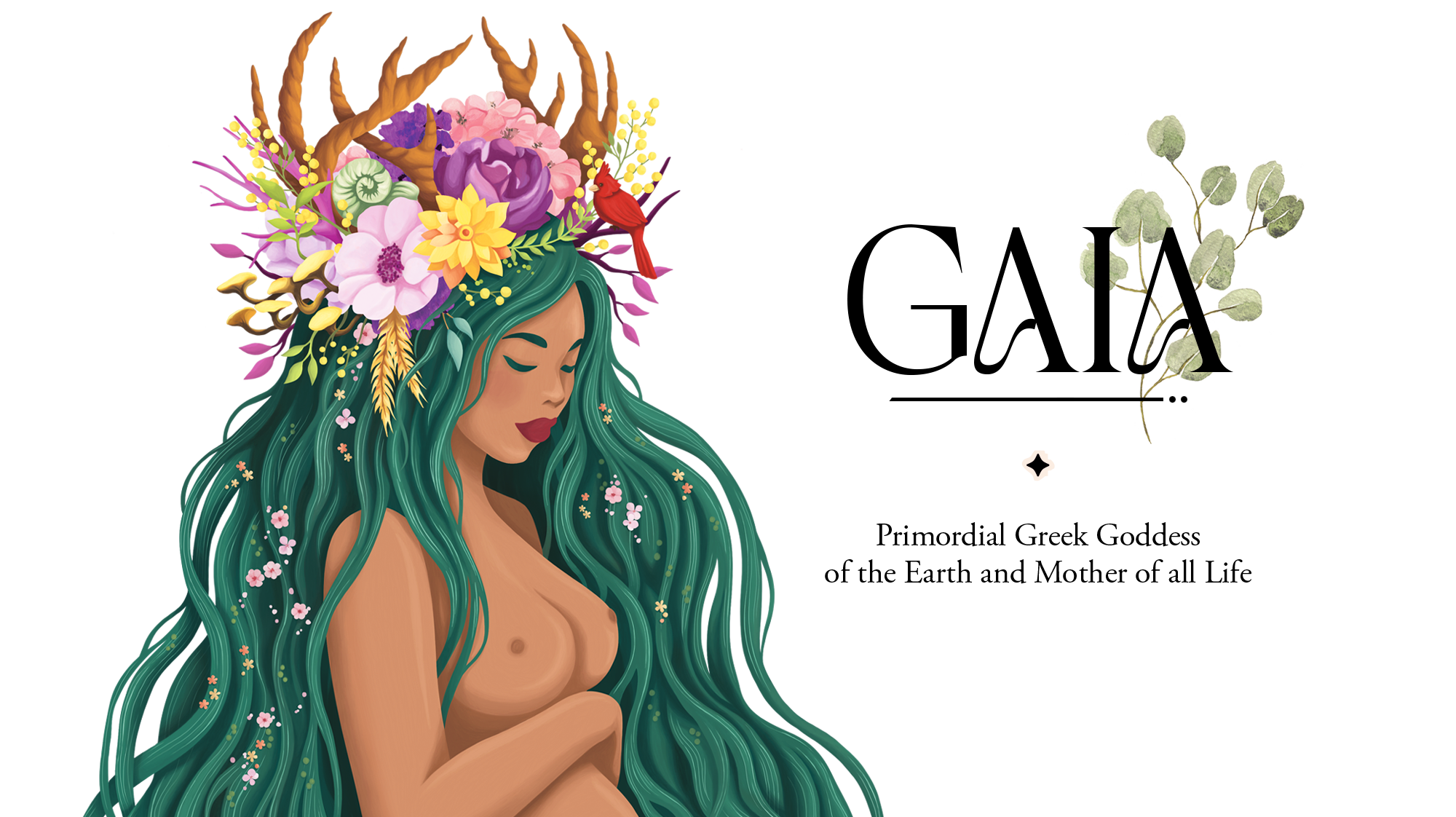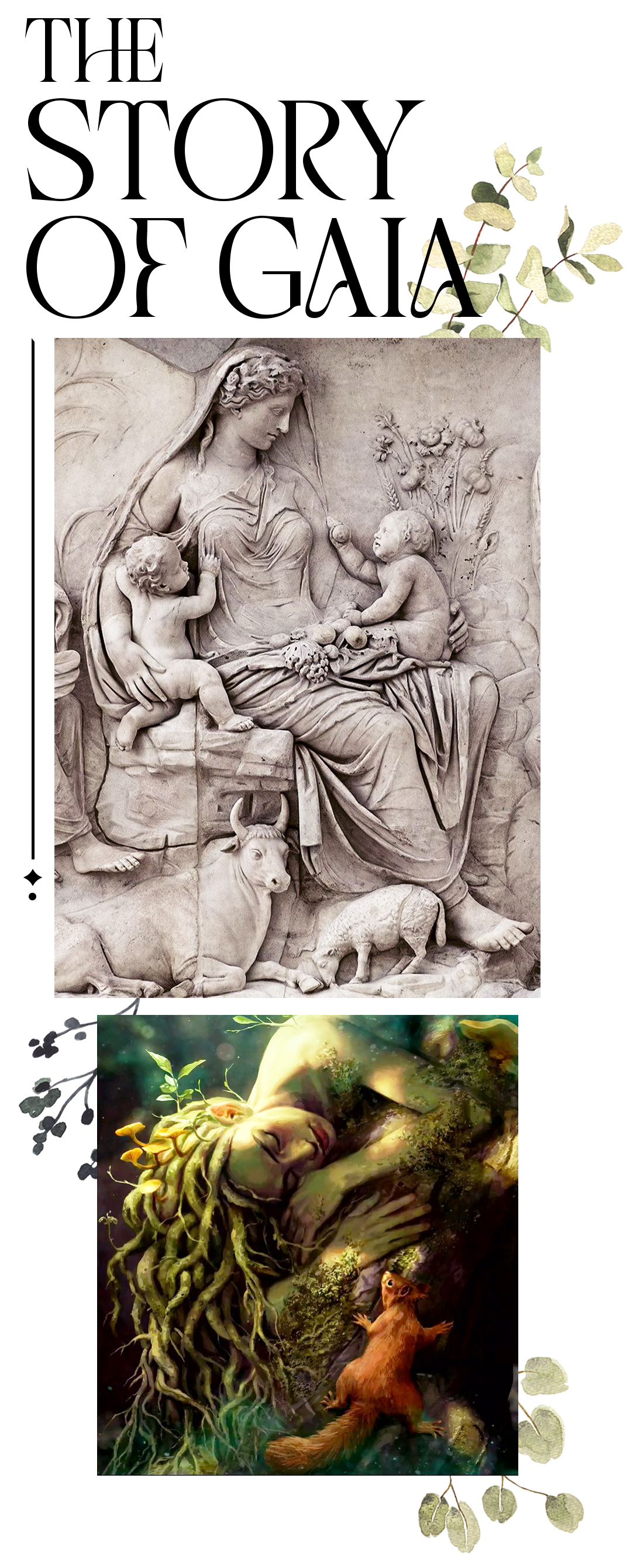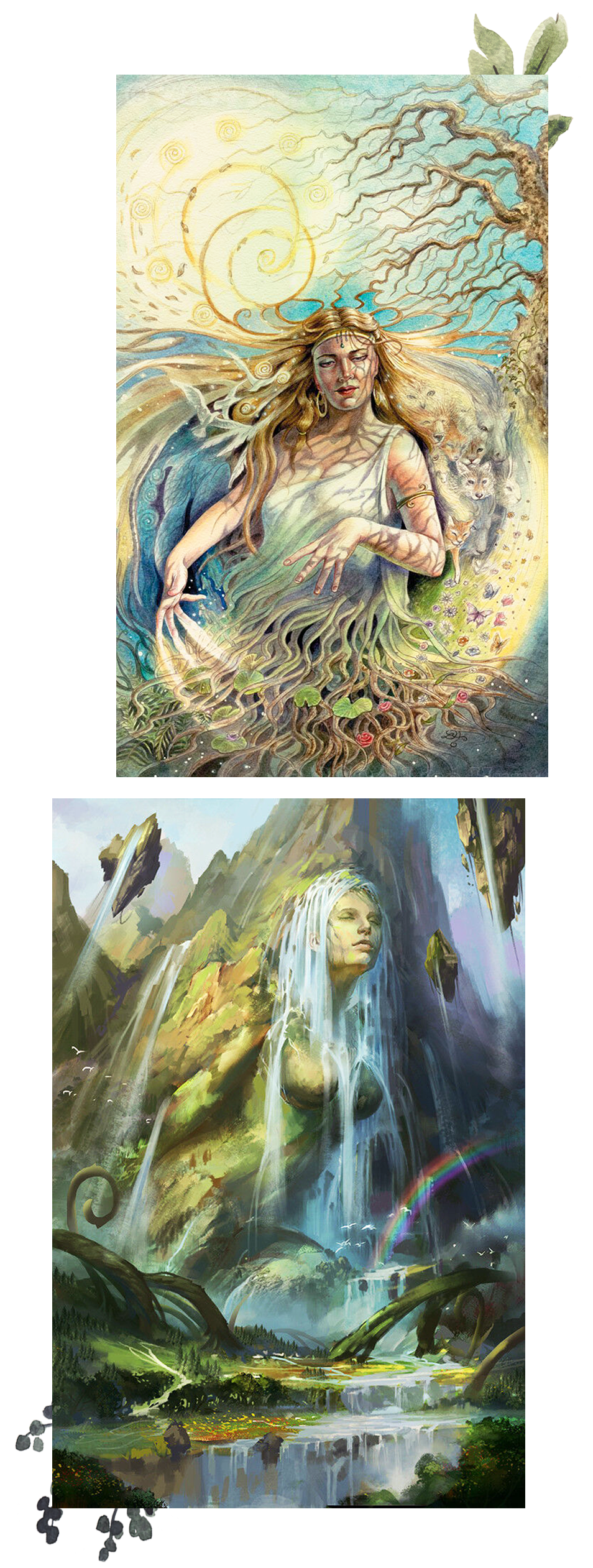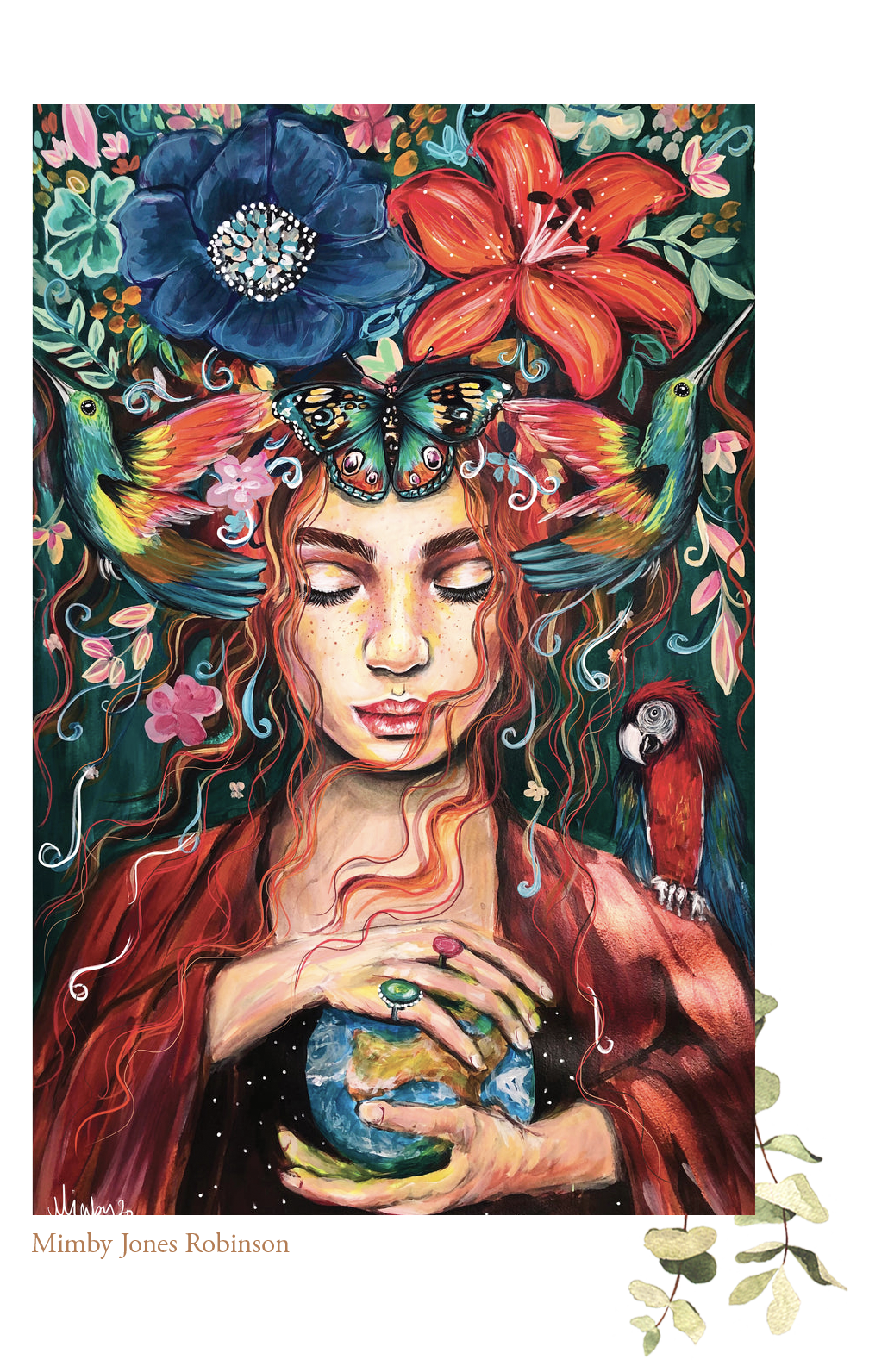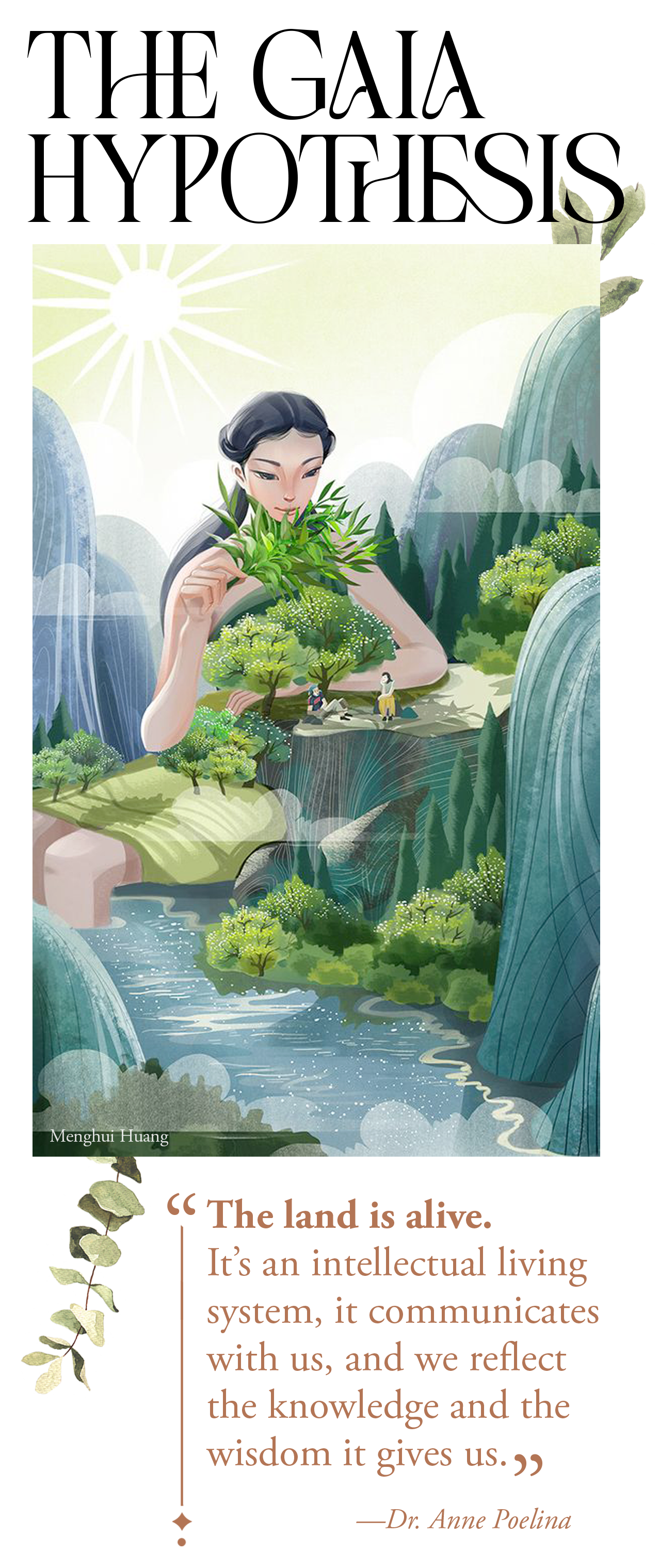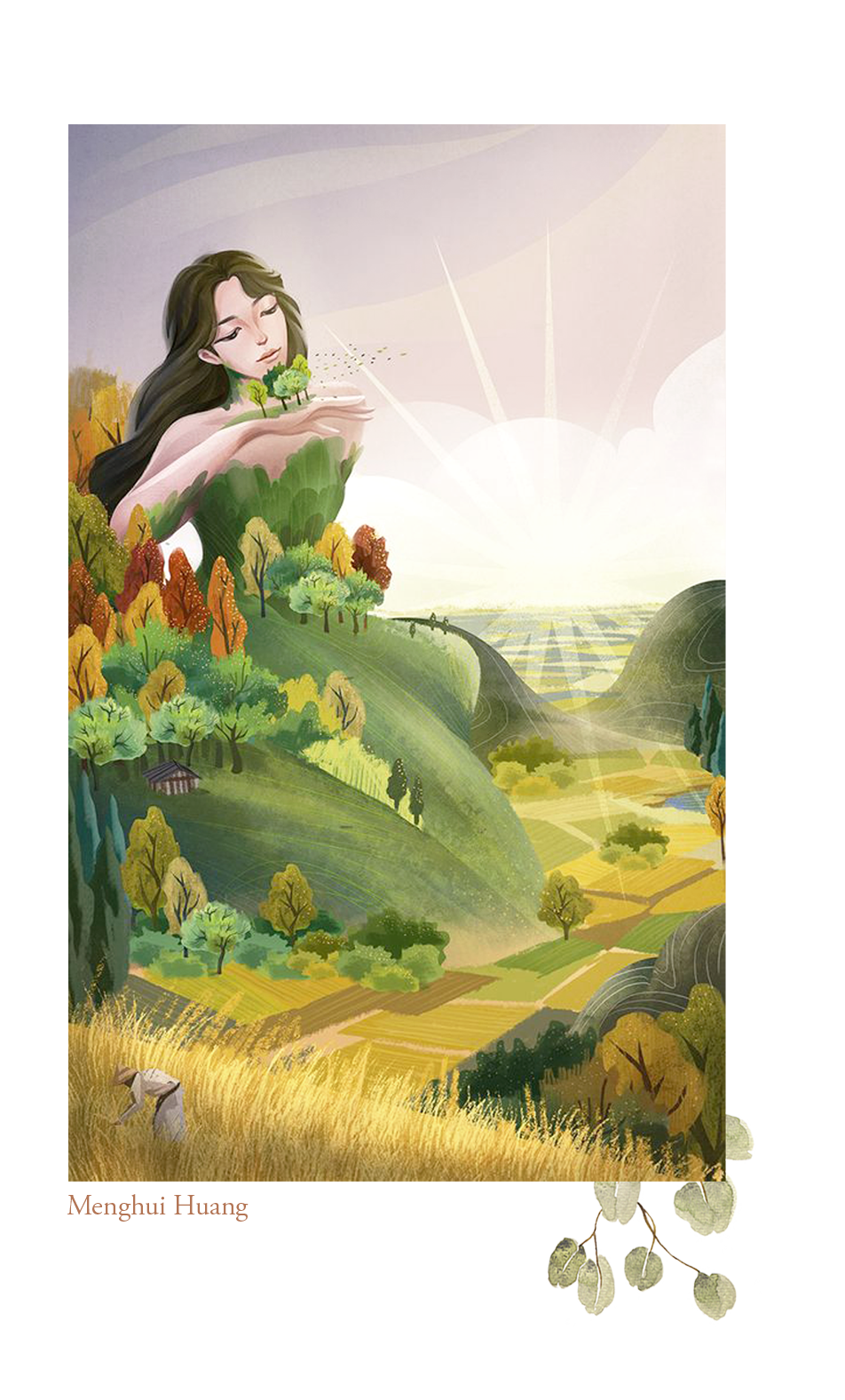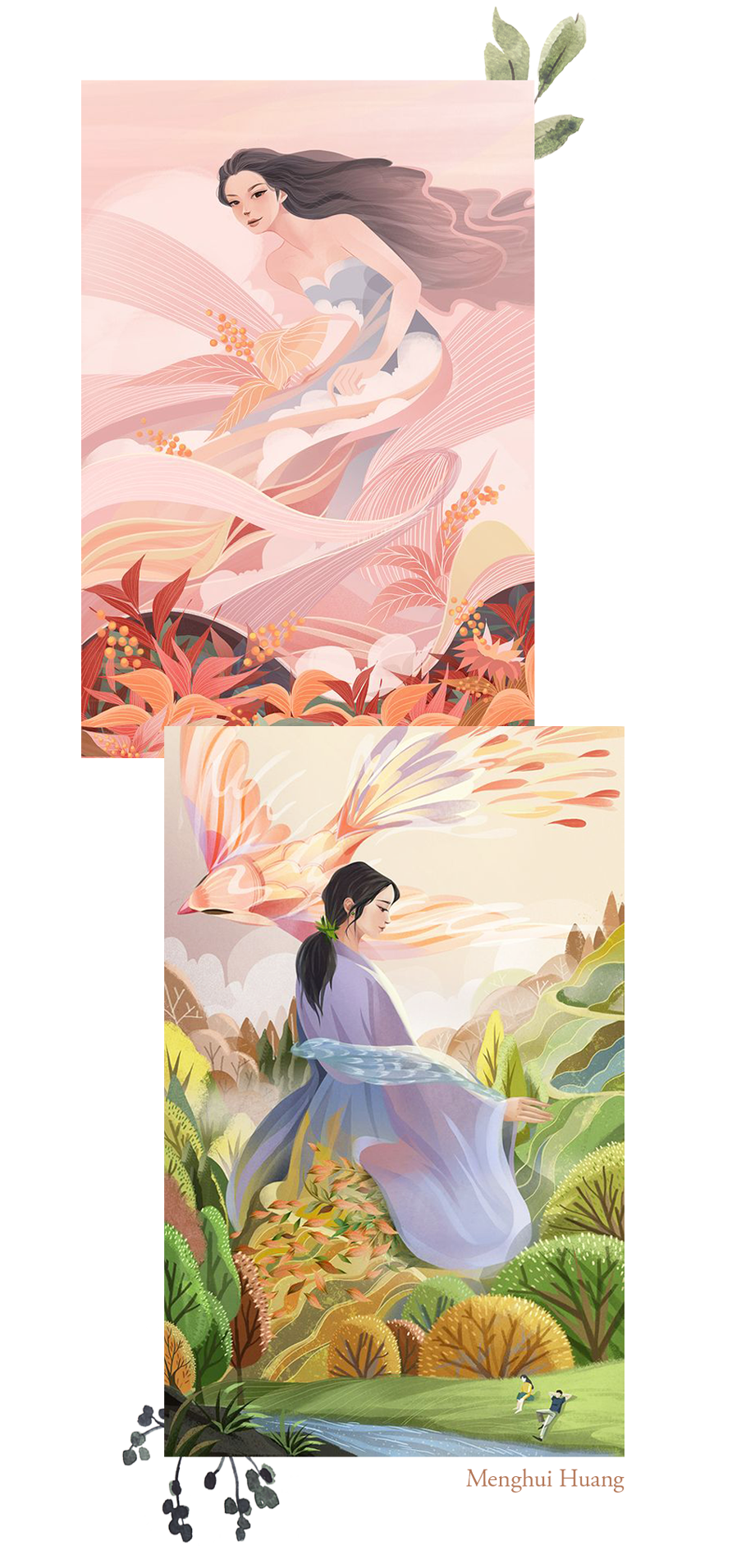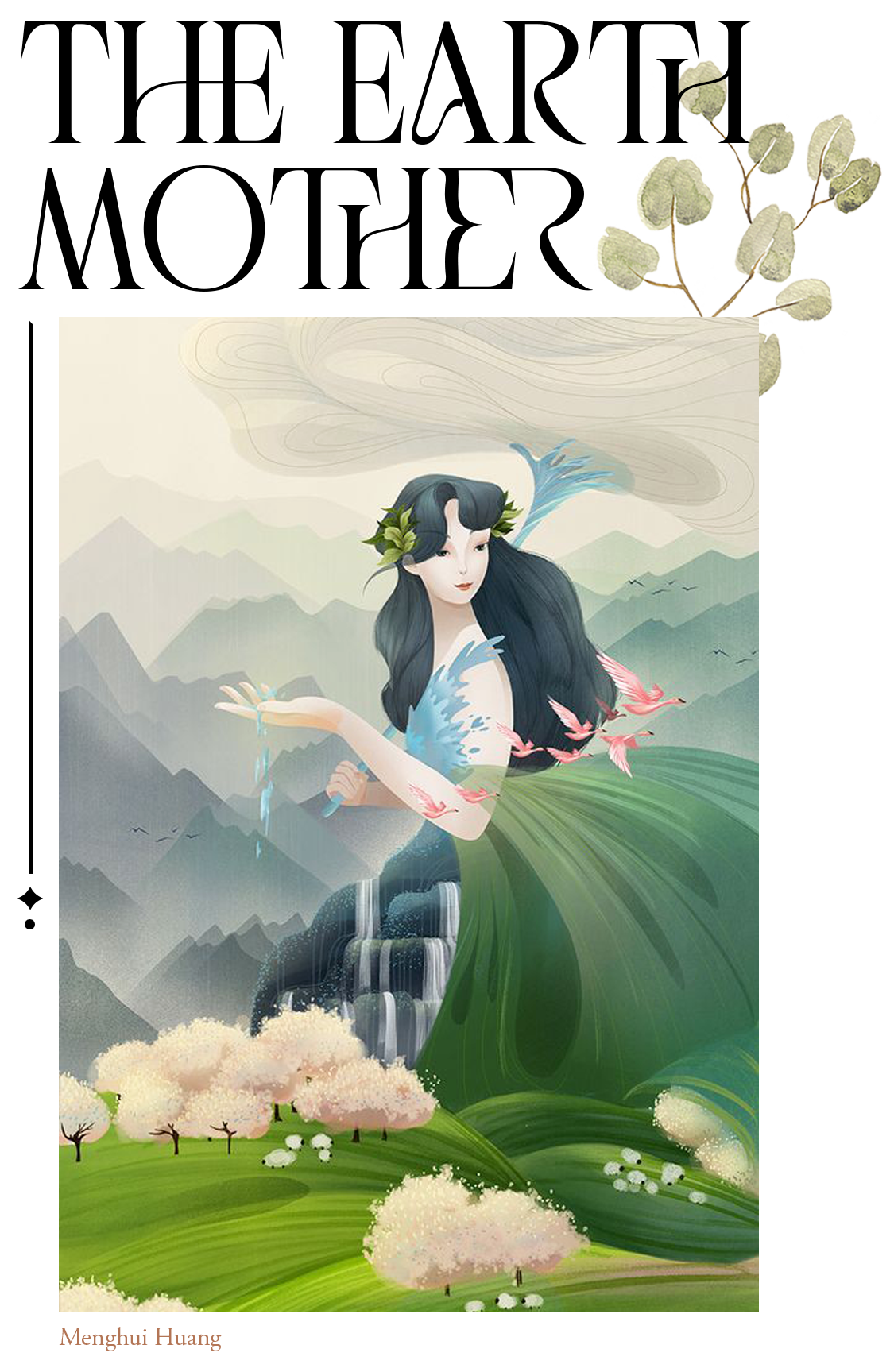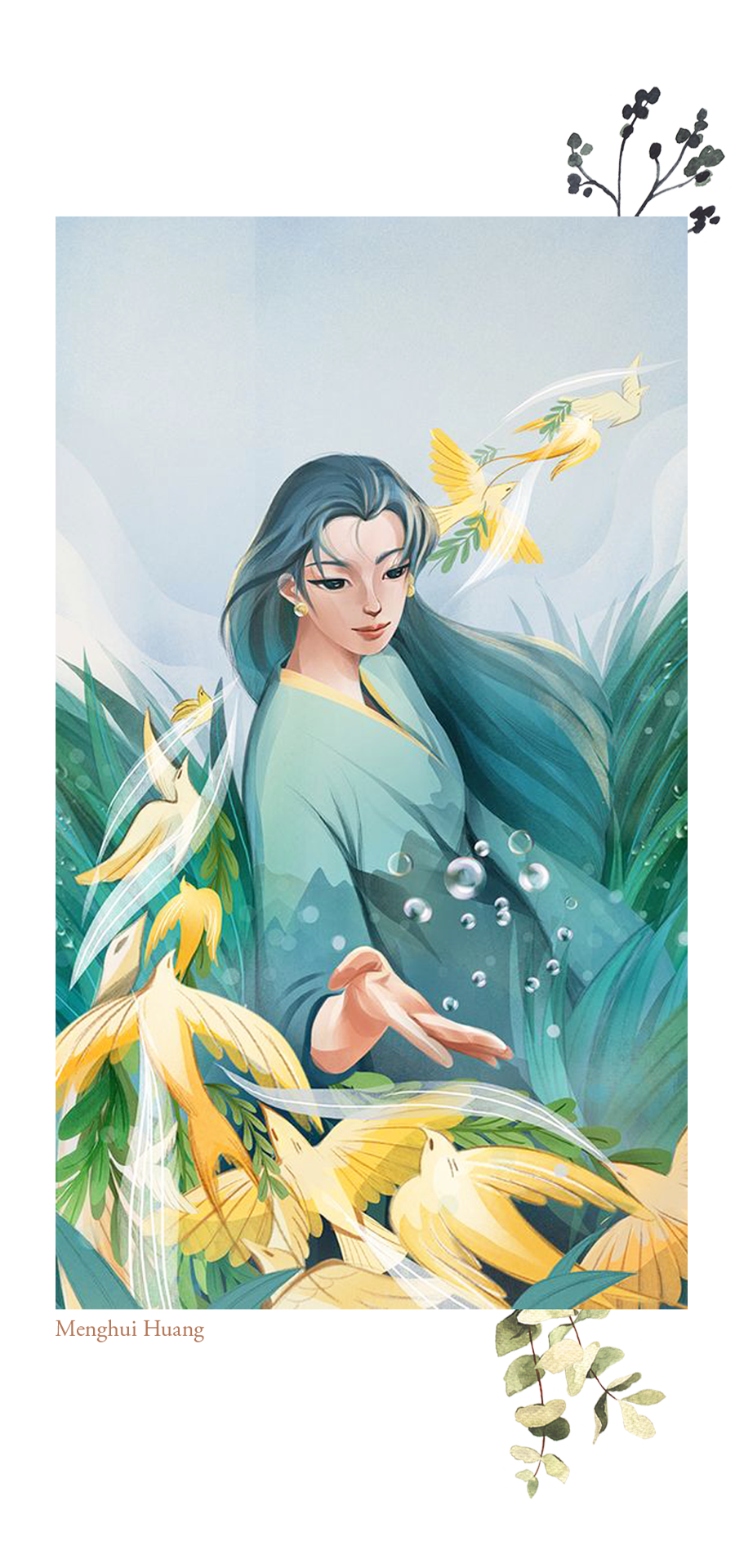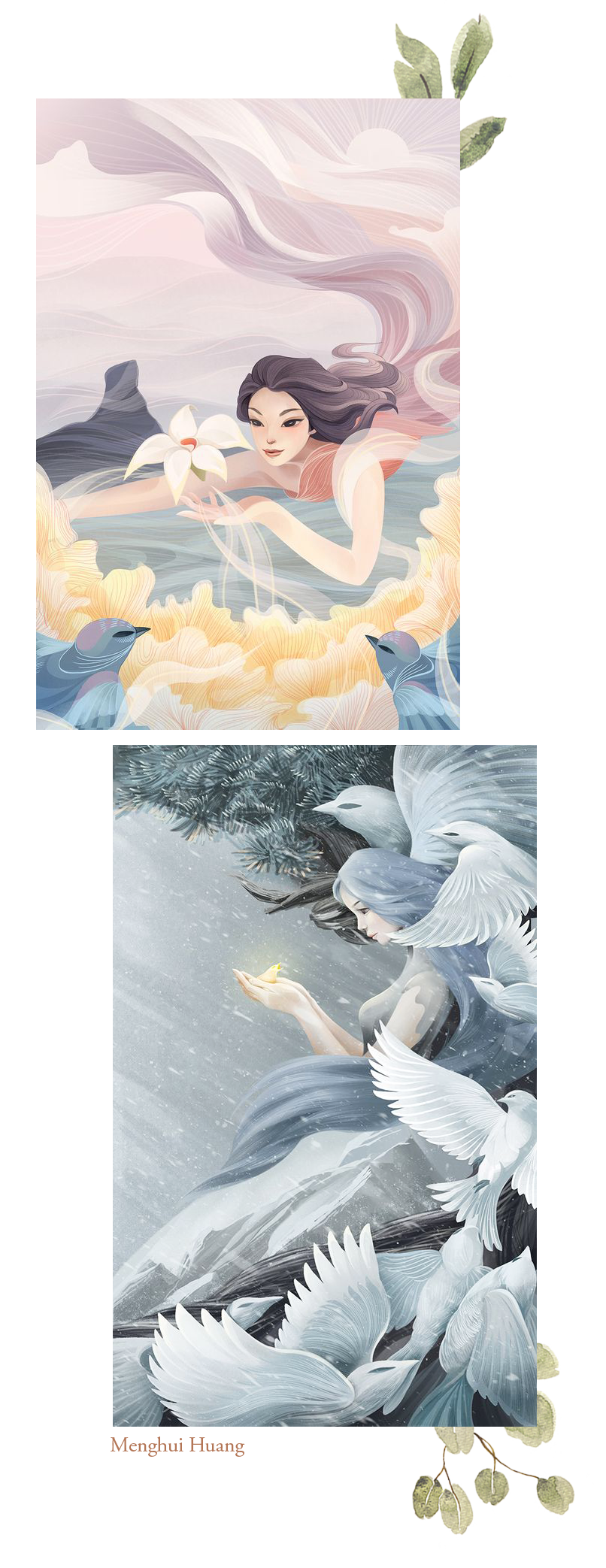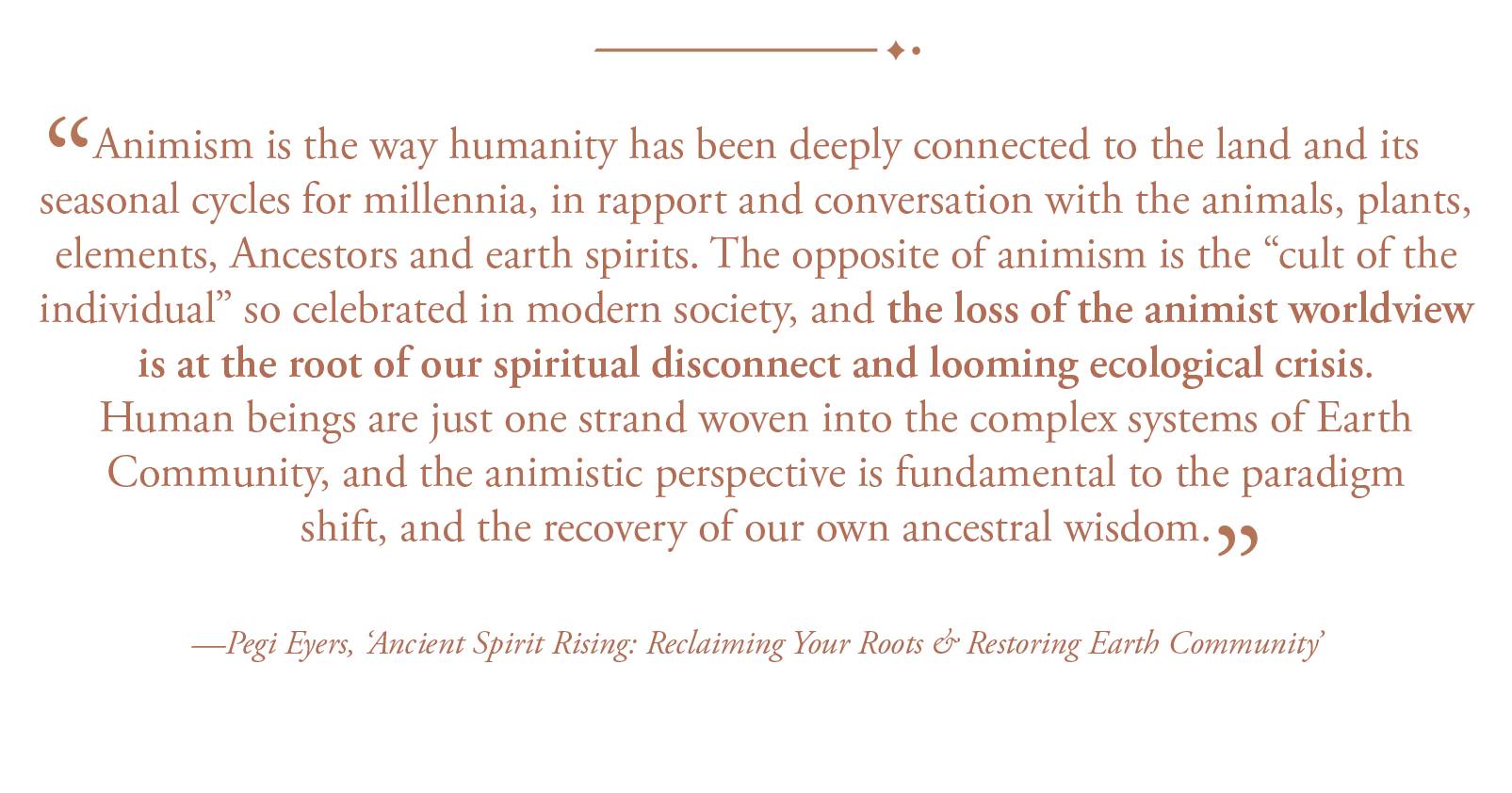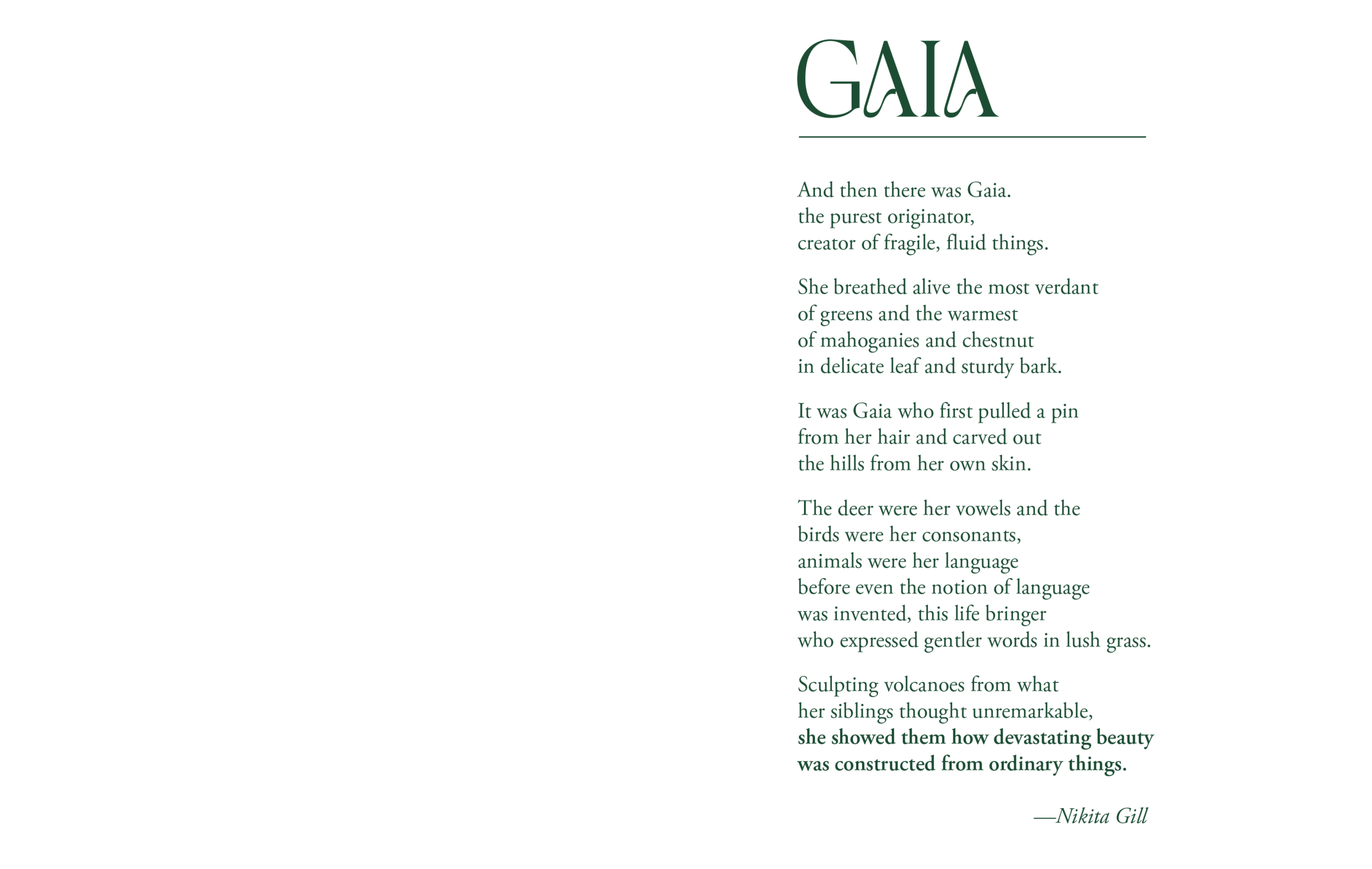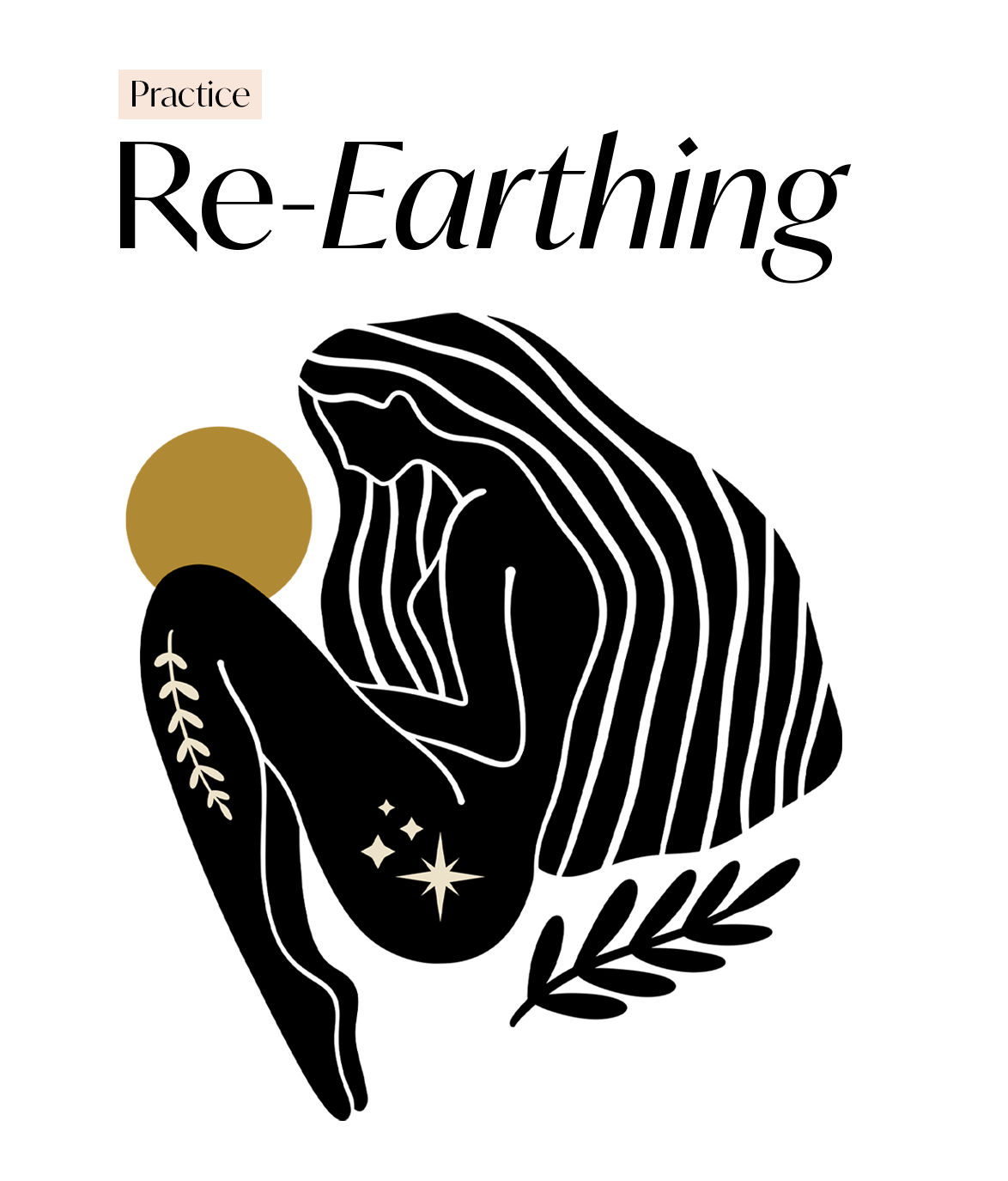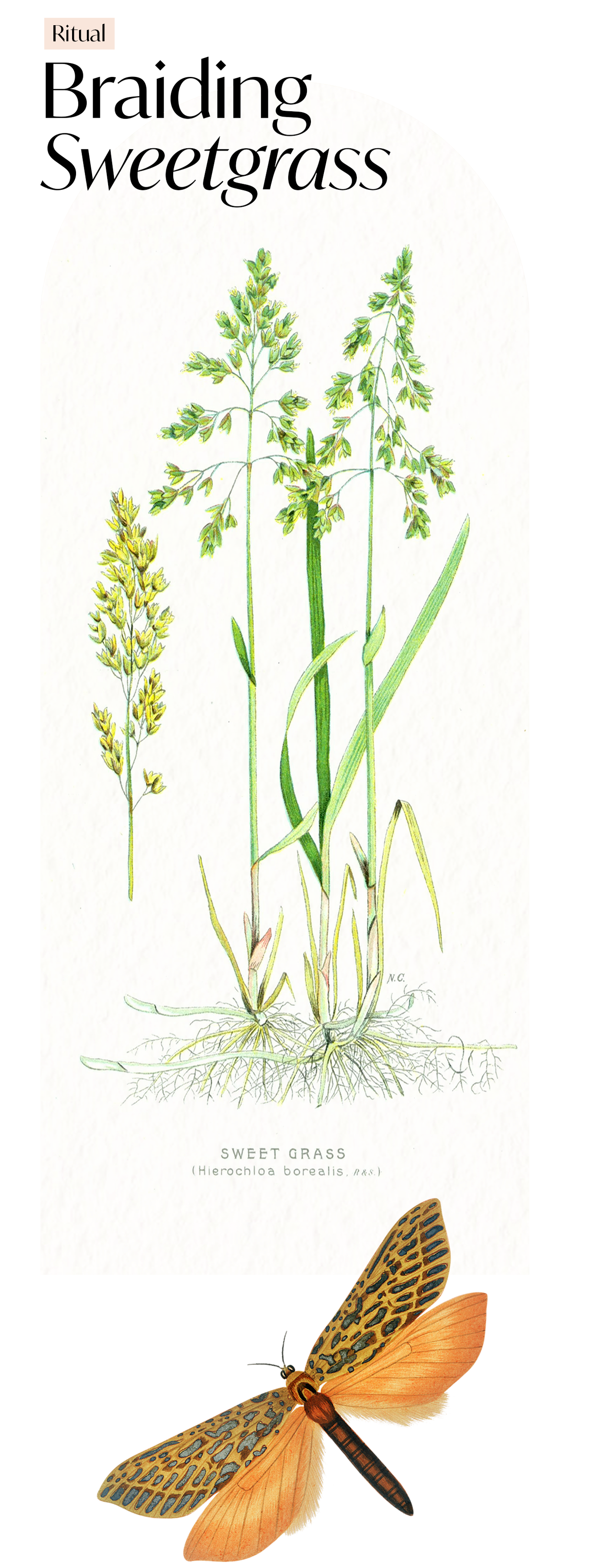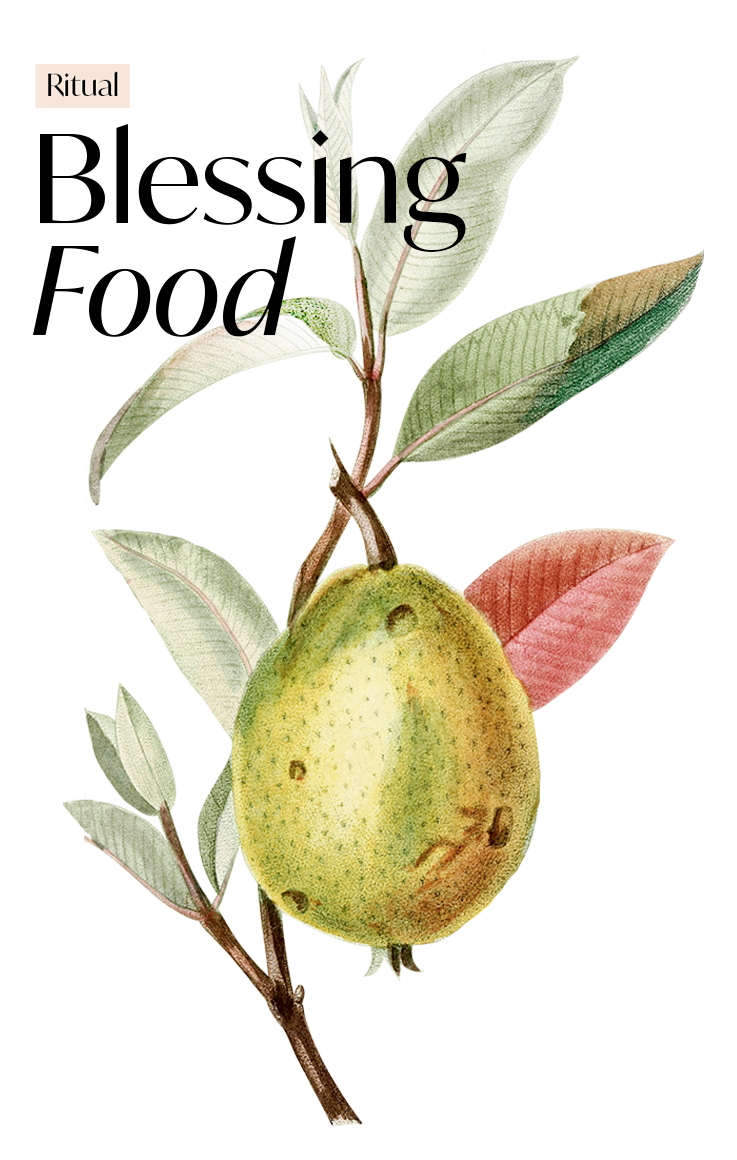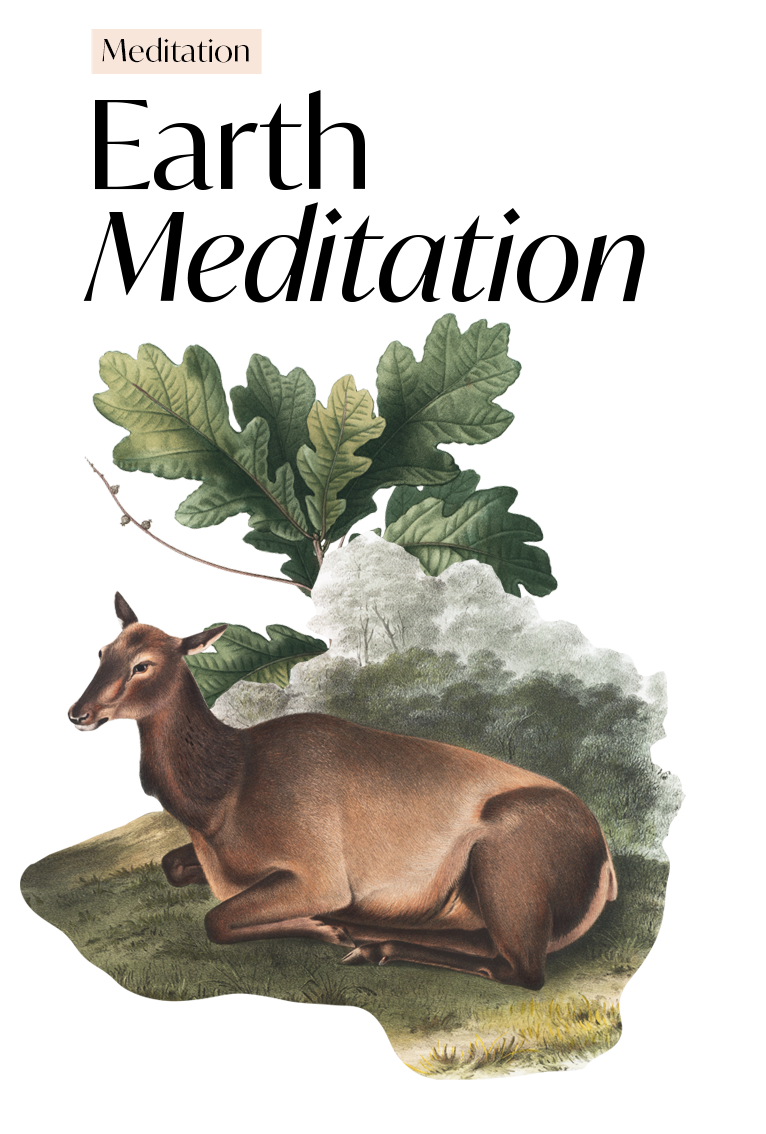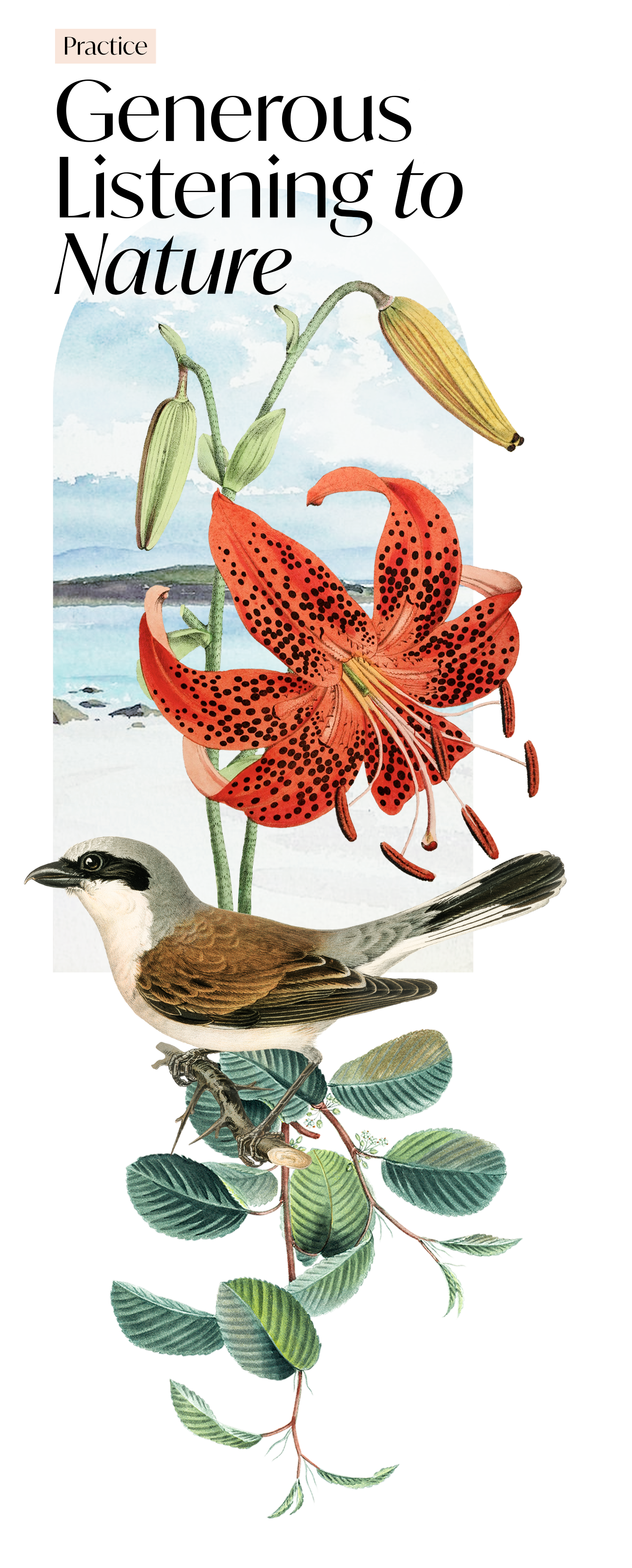Other names: Gaea, Ge, Mother Earth.
Commonly associated with: Earth—especially as a living organism, femininity and female power, fertility, agriculture, motherhood, renewal and rebirth, environmental consciousness, ecology, and the green movement.
Abilities: Ability to create life on Earth, gift of prophecy, healing, regeneration, omnipresence, immortality, shapeshifting, animal empathy, plant manipulation, plant mimicry, nature manipulation, omniscience.
Symbols: Earth, fruits, grains, plants, animals, cornucopia, sickle.
*
In Greek mythology, Gaia is the personification of the Earth and one of the Greek primordial elemental deities, born at the dawn of creation. Gaia is the ancestral mother of all creation, the great Mother of all Life. She is sometimes considered a parthenogenetic goddess—a virgin goddess who requires no male partner to produce the cosmos, earth, life, matter, and even other gods out of her own essence. Gaia herself was born from Chaos, emerging from the void. She then gave birth to Uranus (the Sky), and everything else on earth, including all the heavenly gods and mortal creatures, born directly from her earthy flesh. Her name comes from the Ancient Greek poetical form of Gē, meaning “land” or “earth”.
Her equivalent in other mythologies include the Roman Terra Mater (mother Earth), the Andean Pachamama, the Egyptian Nut, the Hindu Prithvi, “the Vast One”, or the Hopi Kokyangwuti Spider Grandmother, who with Sun god Tawa created Earth and its creatures.
*
Some modern historians and archeologists, including Marija Gimbutas, claim that Gaia as Mother Earth is a later form of a pre-Indo-European Great Mother, venerated in Neolithic times. Some modern mythologists, including Kerenyi, Ruck, and Staples, interpret the goddesses Demeter the mother, Persephone the daughter, and Hecate the crone, as aspects of a former great goddess identified as Gaia or Rhea—Gaia’s Titaness daughter. In Crete, a goddess was worshiped as Potnia Theron (‘Mistress of the Animals’) or simply Potnia (‘Mistress’), speculated as Gaia or Rhea. The mother goddess Cybele from Anatolia (modern Turkey) was partly identified by the Greeks with Gaia, Rhea and Demeter.
The Greeks worshipped Gaia in nature, in the open, as well as in Delphi, before the sacred site was rededicated to the Greek god Apollo. Gaia was honored side by side with her granddaughter, the goddess Demeter. Statues of Gaia were found in temples dedicated to Demeter, and Gaia was part of the cult of Demeter. Like her grandmother, Demeter became the goddess of agriculture and the harvest.
*
Gaia’s supernatural abilities include: Creation—the ability to create life from nothing, not requiring a consort, Omniscience—Gaia has seen, heard, and understood everything that has happened since the creation of the earth, Animal empathy—the power to empathize with animals, Nature manipulation—the power to manipulate the forces of nature, Shapeshifting—the ability to assume the form of any being on Earth, Water and plant mimicry—the power to transform into or have a physical body made up of water or plants, and Nature Guardianship—the ability to be a protector and keeper of nature and natural forces.
*
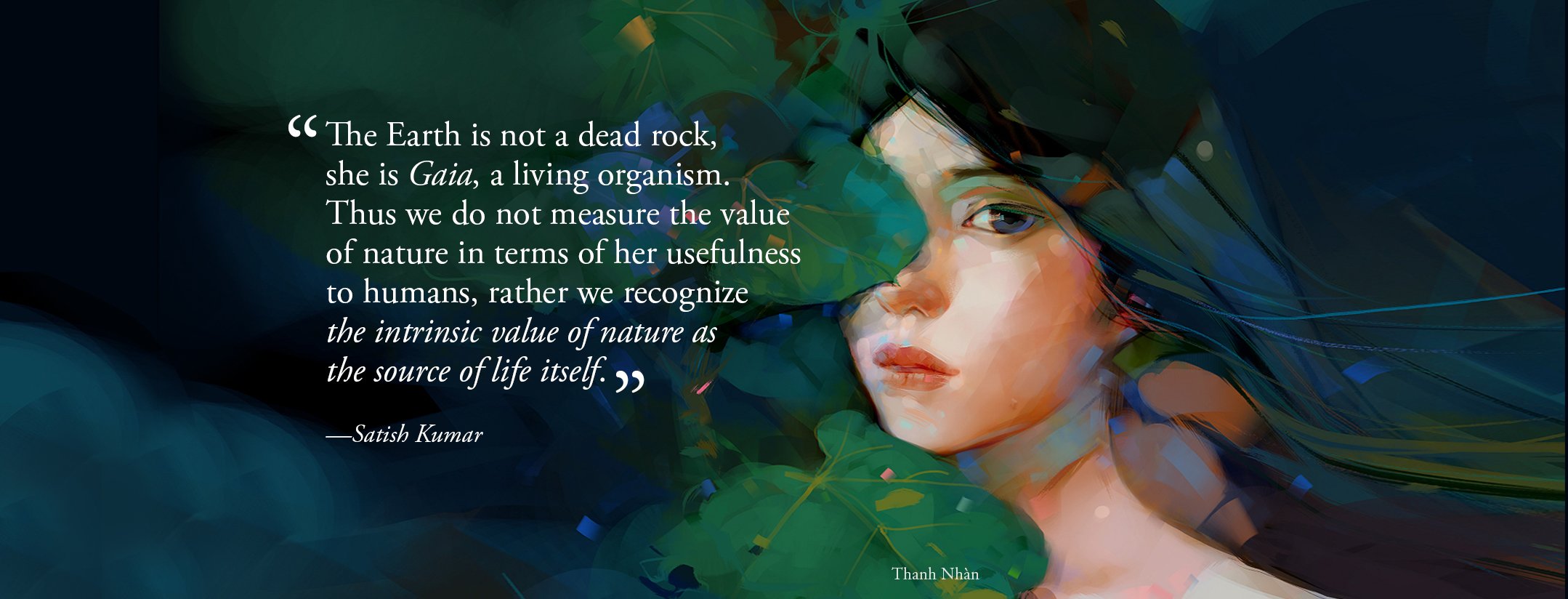
The Gaia Hypothesis, also known as the Gaia theory, Gaia paradigm, or the Gaia principle, suggests that the entire surface of the Earth (including life) is part of a single self-regulating complex system. This complex system is responsible for regulating conditions on Earth that are favorable to all life, from the surface rocks and oceans to the atmosphere and humanity. Living organisms concentrate useful elements, compounds, and nutrients, and redistribute them into the water, soil, and atmosphere where they stabilize climate, feed other life forms, and influence the environment in which they evolved.
The theory that the Earth is a self-regulating super-organism was proposed by inventor and scientist James Lovelock, and co-developed by microbiologist Lynn Margulis, in the 1970s. Named after the primordial Greek goddess of the Earth, the Gaia theory counters beliefs that humans are separate from Earth, and have ownership and domination over it. James Lovelock’s seminal book, Gaia, published 40 years ago, helped shift popular perceptions about the Earth. In 2006, the Geological Society of London awarded Lovelock the Wollaston Medal in part for his work on the Gaia hypothesis.
*
*
The Gaia Theory was first critiqued very heavily by evolutionary biologists who claimed there was no place for Gaia as it was ‘anti-Darwinian’ in nature. The hypothesis proposes that living organisms and inorganic material are part of a dynamical system that shapes the Earth’s biosphere, and maintains the Earth as a fit environment for life. In some Gaia Theory approaches, the Earth itself is viewed as an organism with self-regulatory functions. Topics related to the hypothesis include how the biosphere and the evolution of organisms affect the stability of global temperature, salinity of seawater, atmospheric oxygen levels, the maintenance of a hydrosphere of liquid water and other environmental variables that affect the habitability of Earth. Further books by Lovelock and others popularized the Gaia Hypothesis, which was embraced to some extent by New Age environmentalists as part of the heightened awareness of environmental concerns of the 1990s.
*
*
While Lovelock originally wrote of Gaia as a resilient system, able to withstand change, the scientist now warns of the stability of the Earth. “The period we are now in is close to a crisis point for Gaia”, he wrote in his book The Revenge of Gaia, in 2007. Lovelock declares, “unless we see the Earth as a planet that behaves as if it were alive, at least to the extent of regulating its climate and chemistry, we will lack the will to change our way of life and to understand that we have made it our greatest enemy”. In his newest work We Belong to Gaia (2021), James Lovelock draws on decades of wisdom to lay out the history of our remarkable planet, to show that it is not ours to be exploited—and warns us that it is fighting back.
*
Since the presentation of the hypothesis—and also due to the neo-pagan revival of Gaia—the goddess has become an indelible symbol of the environmental movement. The quintessential Earth goddess has transcended the ages to become an important symbolic figure in modern times. Gaia has always represented the ability to create life on Earth and the Earth itself. As the personification of our planet, she gives us a focal point, helping us to conceptualize our relationship with the Earth and nature.
In the modern world that has lost its connection to myths and magic, the goddess Gaia has come to symbolize reverence for nature, environmental consciousness, and recognition of this planet’s miraculous ability to support life. It is time we learn to live with Gaia, aware of our role within its complex interconnected system, and not separate from it.
*
*

To ancient Earth-honoring cultures, the understanding of the Earth as a living, conscious being was a deep and central part of spirituality. Human and Earth Mother were both deeply honored and sacred: the feminine was revered as a great life-giving power able to conceive, give birth, and nurture children from their womb, similar to the miracle of the Earth Mother who gave birth to all creatures, nurtured the crops in the summer, gave life-sustaining rain, protected the crops during the winter, and brought them back to life again in spring.
*
*
The oldest living religion, Animism, was the way by which most ancient people (and many Indigenous people to this day) experienced the world. Animism is the belief that objects, places, and creatures all possess a distinct spiritual essence. Animism perceives all things—animals, plants, rocks, rivers, weather systems, and perhaps even words—as animated and alive in their own right, as imbued with the quintessence of Spirit. The concept of personhood is not exclusive to humans, but rather humans are just one kind of person in a much wider field of kinship or relatedness. Just like human persons, there are stone persons, tree persons, bear persons, microbe persons, deities who are persons, stars and planets and ancestors, and many other persons who have agency, consciousness, culture, community and bodies, whether or not they’re visible to us. For animists, anything that has a physical existence contains within it a unique personality, energy, and expression of Spirit.
*
To all ancient people, the Earth was alive, a great animal inhabited by a life-spirit, or “soul-substance.” All phenomena were manifestations of this divine force, and after death all forms returned to this source before transitioning to another animate existence. The earth spirit was the “central transformer” of all life-energies into the multiplicity of life-forms, all connected with each other as in the same body, the same imagination. In some ways, this ancient conception of the Earth is being re-introduced in the modern western world, partly thanks to the Gaia hypothesis, and to the contemporary interest in animism (‘new animism’), which see the Earth as a living, breathing, and co-responding body, creating its own atmosphere, filling its own needs, relieving its own stresses. Far from the “patriarchal-mechanical model of earth as a merely passive receiver of stimuli from the sun and sky, this model shows us an intentional organism, exhibiting will and direction, and quite capable of reciprocal relations with all its creatures” (The Great Cosmic Mother).
*
*


*
Here, you will find simple earth-based and nature-oriented practices, prompts and rituals that will help you connect with Gaia.
*
*
Re-earthing is a sacred practice to help you plug into the consciousness of the Earth in a truly grounded, healing and nurturing way. To re-earth yourself, try to spend a little time each day in physical contact with the Earth. Physical touch—barefoot, or with hands on dirt or grass, or touching plants or trees—is sufficient for this process.
*
Re-earthing can be a very simple practice of presence and grounding, or it can be a deeper spiritual practice of connecting the heart, body and spirit with the Earth. Earthing can provide our entire system with a deep sense of safety and security, reduces stress, and allows us to connect with our intuition and cultivate gratitude. By practicing earthing, we become more in tune with Mother Earth. We learn to both receive from her and give to her.
While practicing earthing, a beautiful addition to connect deeper can be to say a simple intention or prayer to the Earth. It might simply be ‘Thank you’. Or it could be a deeper and more personal conversation about gratitude, hope and trust and about the wise use of your creative power to support the Earth. You might ask for Mother Earth’s guidance so that you can honor her in the best way possible, according to your talents and abilities. The more you do this practice, the more love and devotion will arise and the stronger and more conscious your connection with the Earth Mother will be.
*
*
In the Potawatomi language, sweetgrass is called wiingaashk—the sweet-smelling hair of Mother Earth. In her book Braiding Sweetgrass, indigenous environmental scientist Robin Wall Kimmerer eloquently and beautifully uses the indigenous cultures’ sacred plant, sweetgrass, as a poetic metaphor to explain the origins of plant, animal, and human life on Mother Earth, their intertwined respectful and reciprocal relationships with each other.
“Our stories say that of all the plants, wiingaashk, or sweetgrass, was the very first to grow on the earth. Accordingly, it’s honored as one of the four sacred plants of my people. Breathe in its scent and you start to remember things you didn’t know you’d forgotten. Our elders say that ceremonies are the way we ‘remember to remember,’ and so sweetgrass is a powerful ceremonial plant cherished by many indigenous nations. It’s also used to make beautiful baskets. Both medicine and a relative, its value is both material and spiritual.
There’s such tenderness in braiding the hair of someone you love. Kindness and something more flow between the braider and the braided, the two connected by the cord of the plait. Wiingaashk waves in strands, long and shining like a woman’s freshly washed hair. And so we say it’s the flowing hair of Mother Earth. When we braid sweetgrass, we are braiding the hair of Mother Earth, showing her our loving attention, our care for her beauty and well-being, in gratitude for all she has given us.”
*
*
Notice how the mother archetype expresses itself in nature. Find manifestations of mothering, creation, compassion, nurture and care within nature and the cosmos, within the plant and animal worlds. What might we learn from how nature expresses mothering and care? How might we embody and mirror nature’s mothering grace and nurture, in our own lives?
*
*
Blessing our food is a beautiful ritual that can enrich our sense of gratitude, improve the way our body processes each meal, and give reverence to the Earth and people who provide us with nourishment. Before you eat, take a moment to look into the food or drink as if you could see backwards, into its history. Thank the Earth for providing you this food, the sun for helping it to grow. Thank the wind and birds for carrying its seed, and the rain that watered it. Use the power of imagination to see where your food comes from and how many people might have been involved in bringing it to your plate. Think of the people who planted, weeded, and harvested the food, the truckers who transported it, the food packagers and plant workers, the grocers and checkout people, and the family members or other cooks who prepared the food. Thank all those people before you take a sip or a bite.
*
*
Ground and center. Take a deep breath. Feel your bones, your skeleton, the solidity of your body. Be aware of your flesh, of all that can be touched and felt. Feel the pull of gravity, your own weight, your attraction to the Earth that is the body of the Goddess. You are a natural feature, a moving mountain. Merge with all that comes from the Earth: grass, trees, grains, fruit, flowers, animals, metals, precious stones. Return to dust, to compost, to mud.
Meditation from The Spiral Dance, by Starhawk
*
*
What if we sincerely listened to nature? Nature is a vast resource of wisdom on revealing oneness and uniqueness. Nature teaches us at least three important things in the journey of Generous Listening.
First, nature offers us endless tools to internalize and to practice slowing down, being present in the moment and being open to surprises. Second, through connecting to nature, one develops the skills of humility and compassion for all living beings and becomes conscious of oneness.
Third, nature is always bountiful and generous. Nature teaches us about reciprocity and generous giving. Nature teaches us to weave a web of intimacy and reciprocity with the living world, to see ourselves as one kind of person in a much wider field of relatedness, in which all flourishing is mutual. When we listen to and learn from Nature, we are invited to enter into kinship, a form of relationship that acknowledges the deeper workings of reality by operating on the same principles as the very breath which keeps us alive: reciprocity, emergence, and sensuous awareness.
Practice by Vuslat Foundation
*
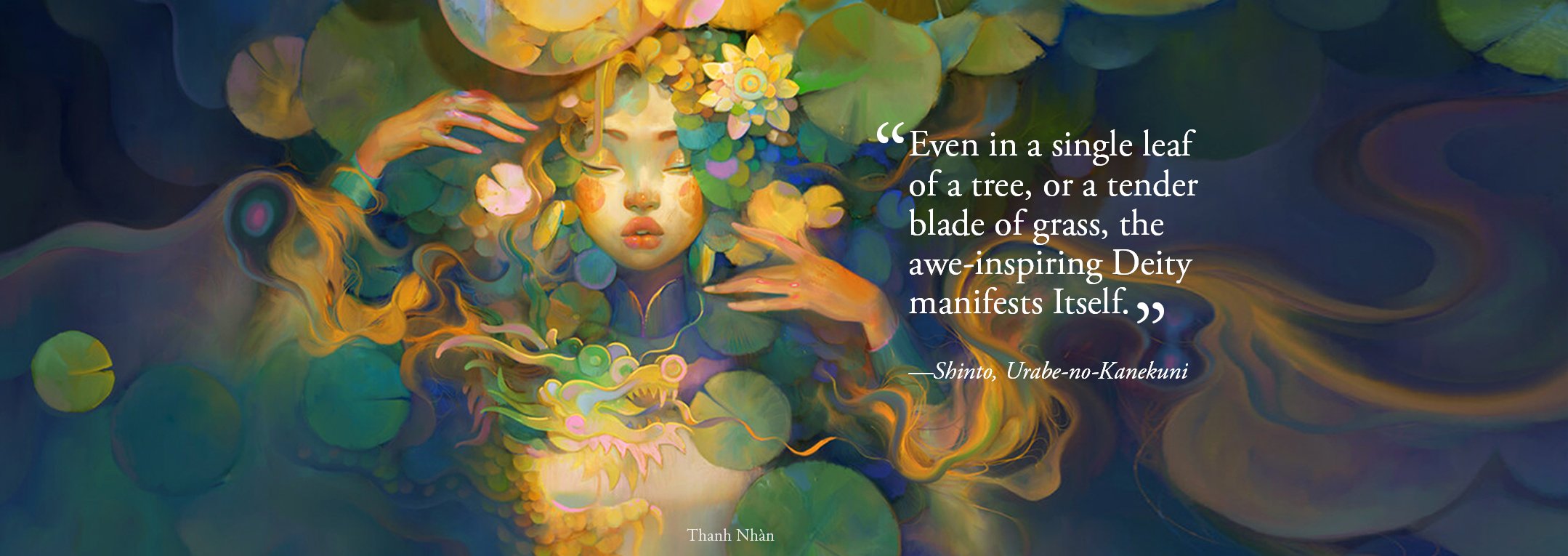
Dive deeper into the world of Gaia, the Gaia theory, animism, spiritual ecology, biophilia and the wisdom of Nature, with these resources including books and articles.
-
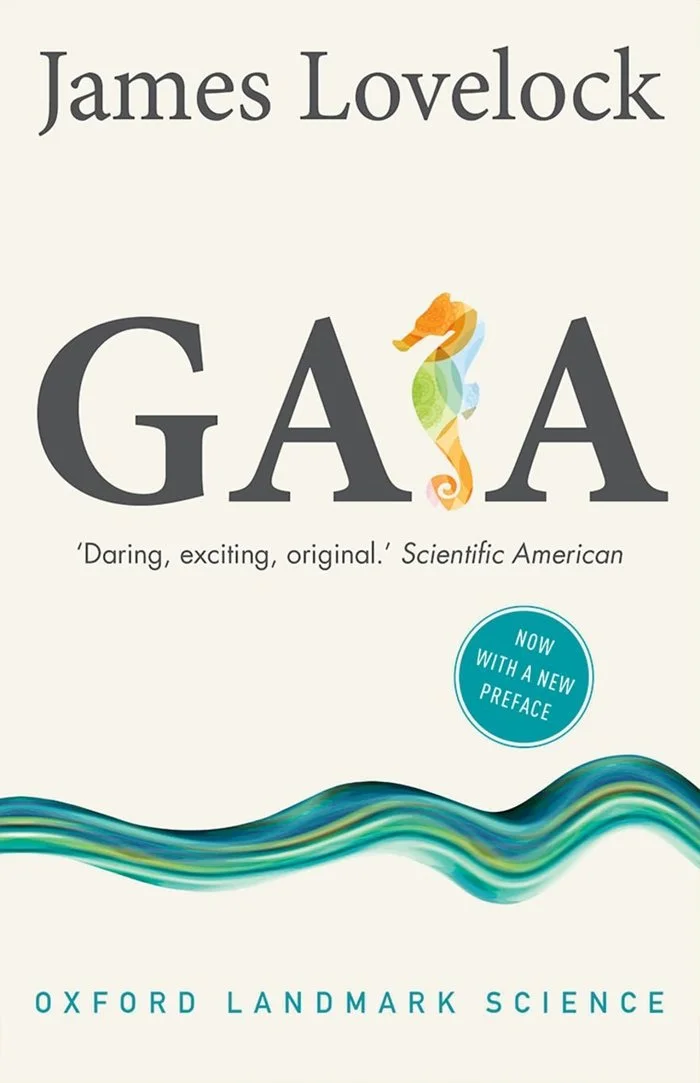
✎ Book
‘Gaia: A New Look at Life on Earth’
by James Lovelock -

✎ Book
‘The Revenge of Gaia: Earth's Climate Crisis & The Fate of Humanity’
by James Lovelock -
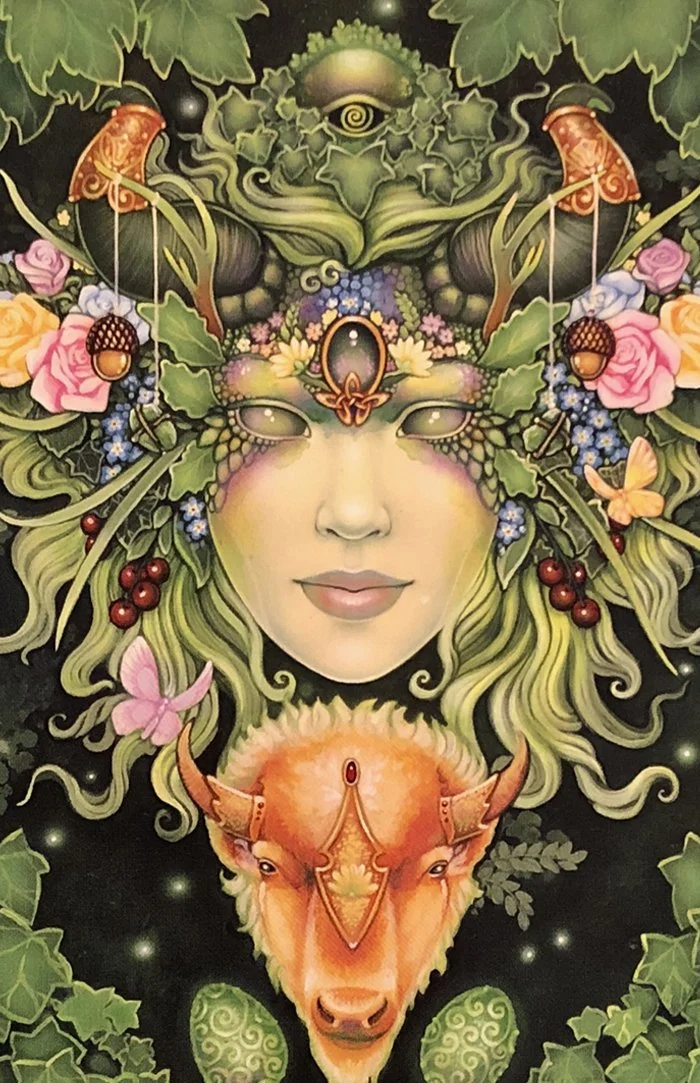
✤ Article
‘Gaia: everything on Earth is connected’
by Rex Weyler -
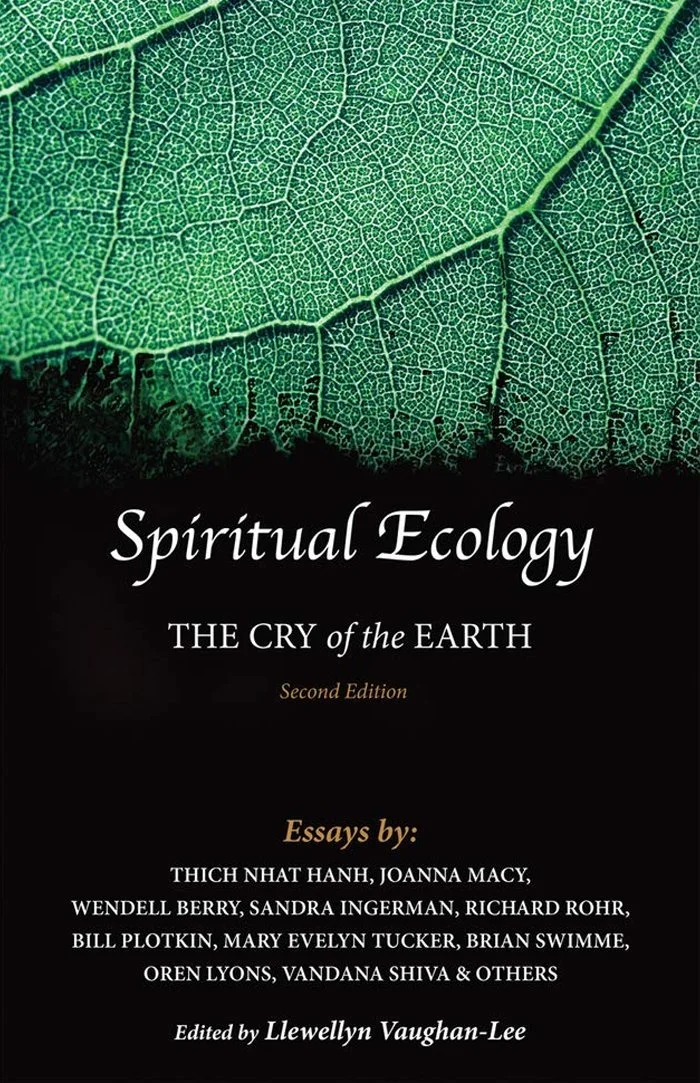
✎ Book
‘Spiritual Ecology: The Cry of the Earth’
by Llewellyn Vaughan-Lee -
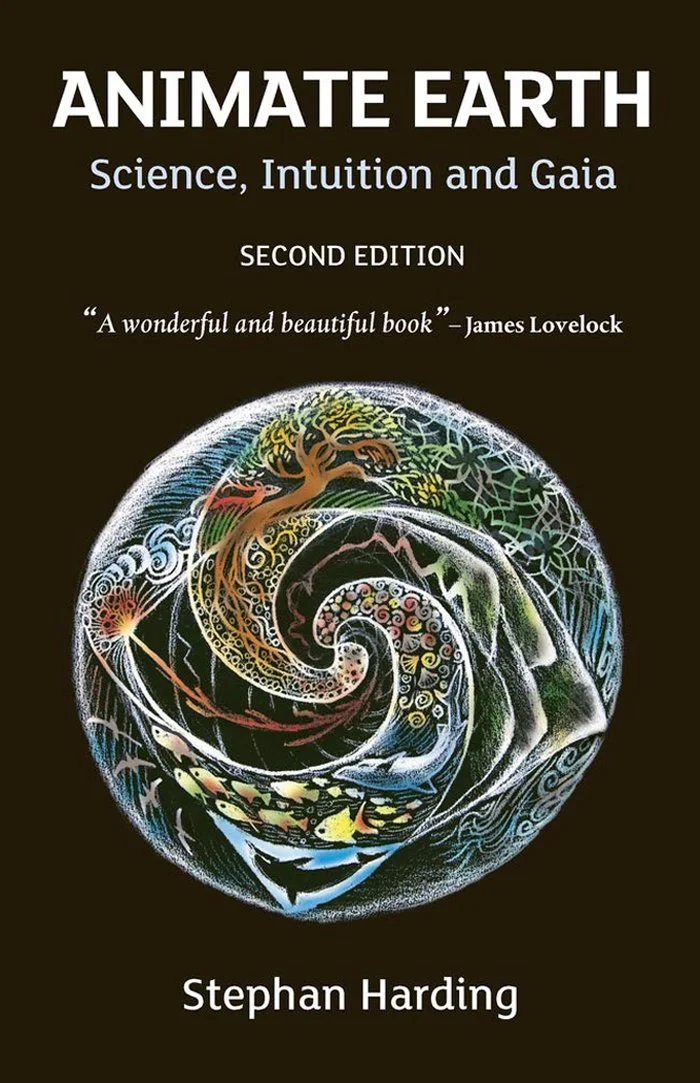
✎ Book
‘Animate Earth: Science, Intuition and Gaia’
by Stephan Harding -
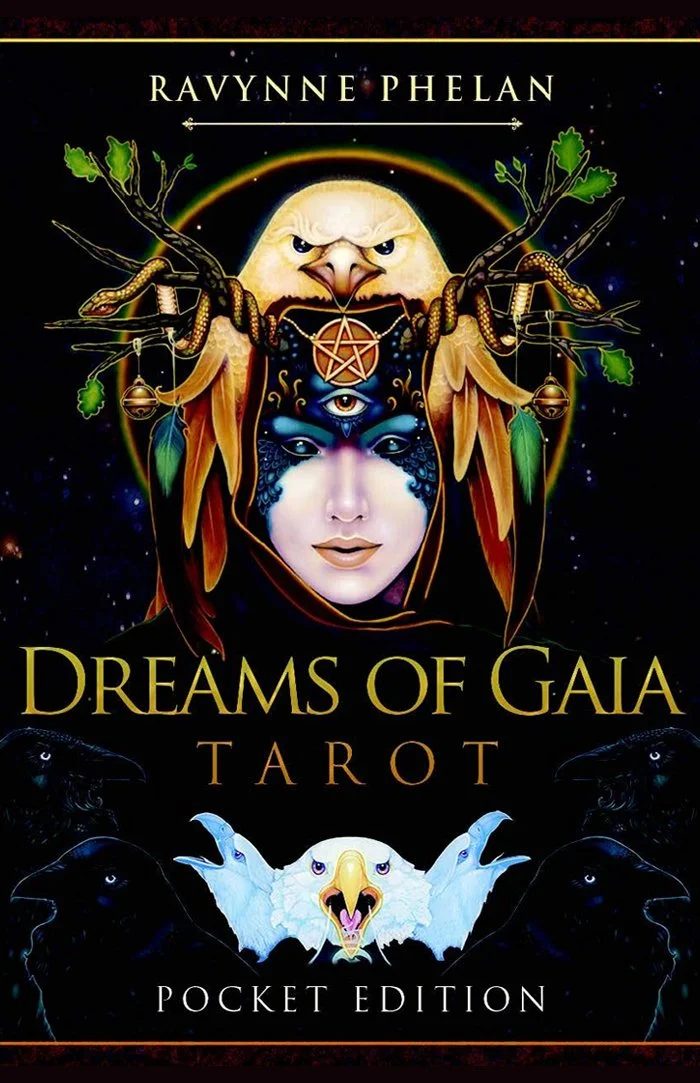
✴ Oracle Deck
‘Dreams of Gaia Tarot: A Tarot for a New Era’
by Ravynne Phelan -
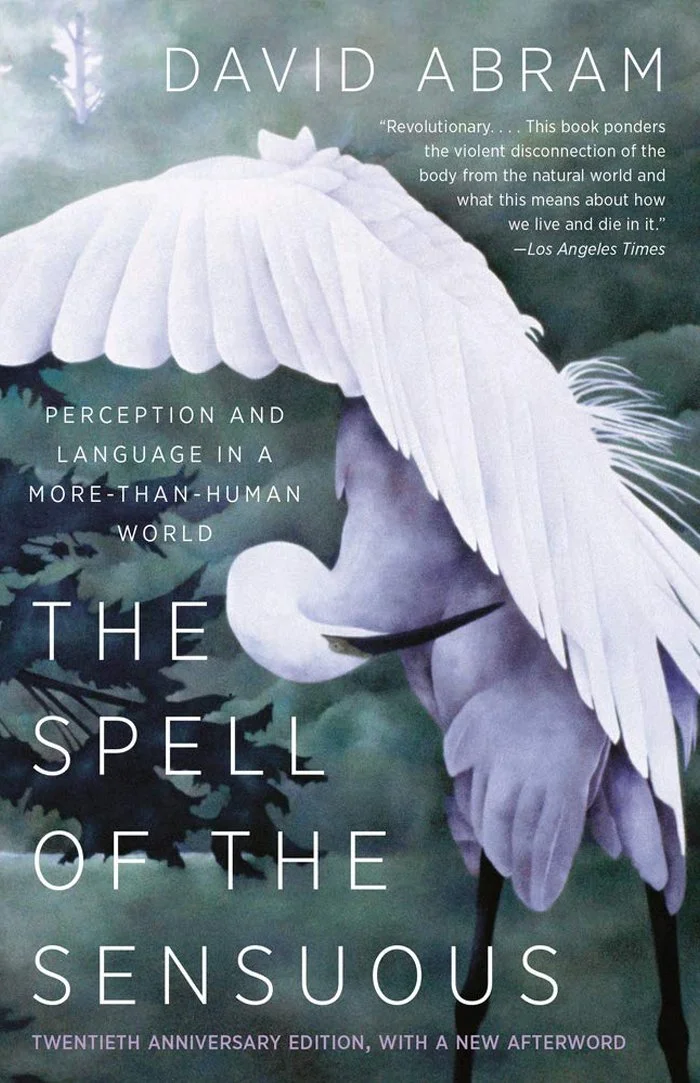
✎ Book
‘The Spell of the Sensuous: Perception and Language in a More-Than-Human World’
by David Abram -

✎ Book
‘Becoming Animal: An Earthly Cosmology’
by David Abram -

✎ Book
‘Animism: Respecting the Living World’
by Graham Harvey -
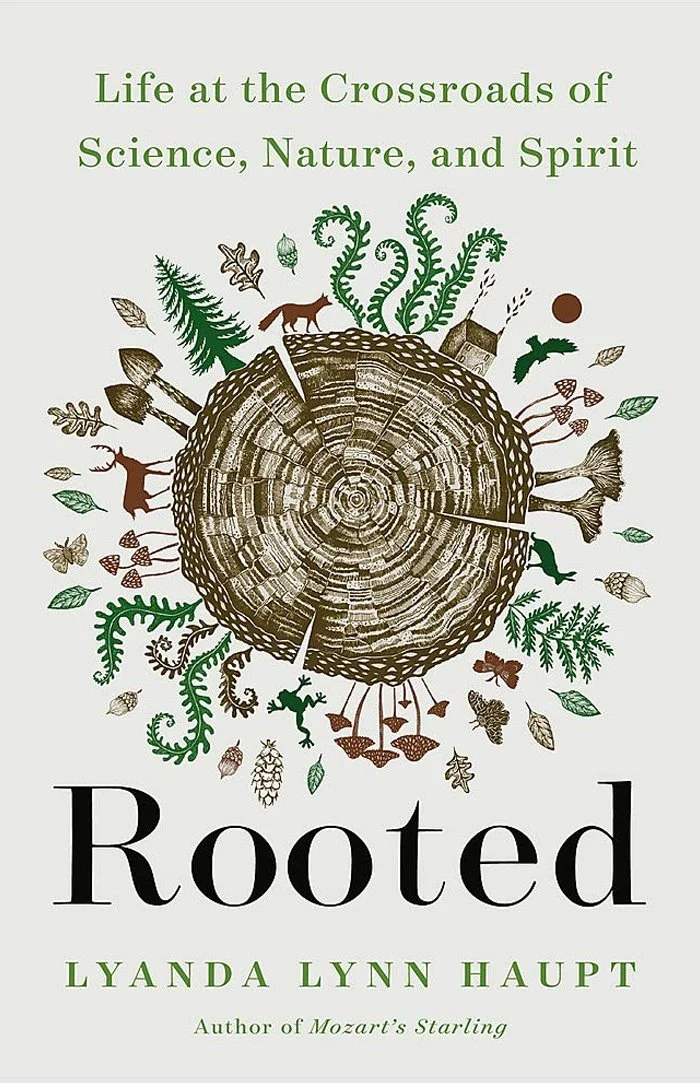
✎ Book
‘Rooted: Life at the Crossroads of Science, Nature, and Spirit’
by Lyanda Lynn Haupt -

✎ Book
‘Sacred Ecology’
by Fikret Berkes -
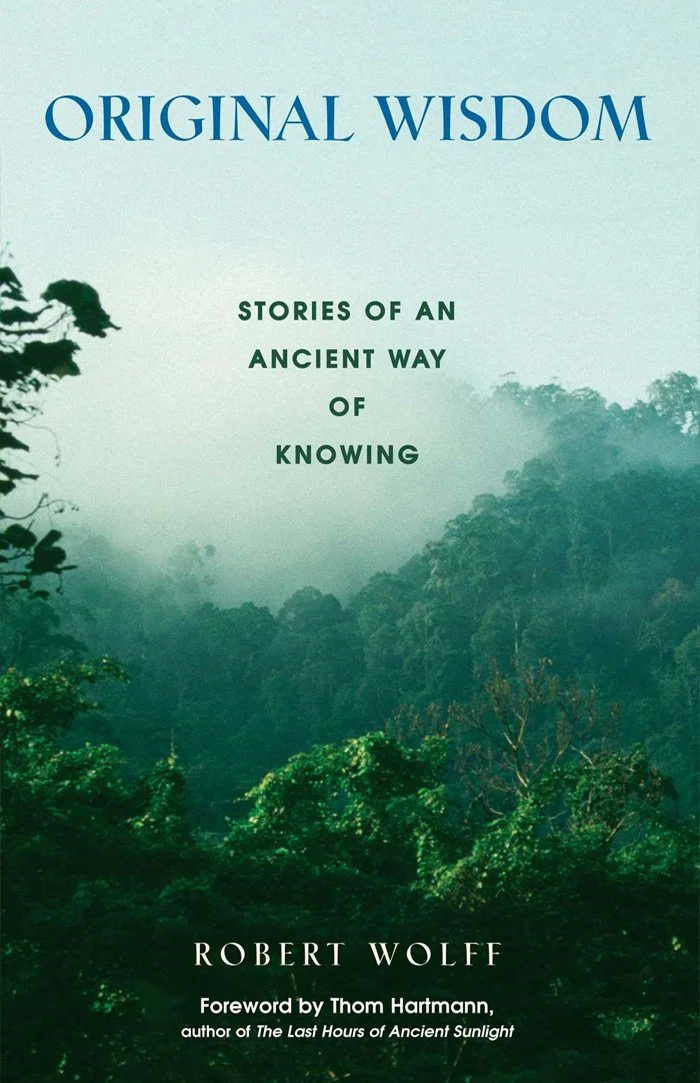
✎ Book
‘Original Wisdom: Stories of an Ancient Way of Knowing’
by Robert Wolff -
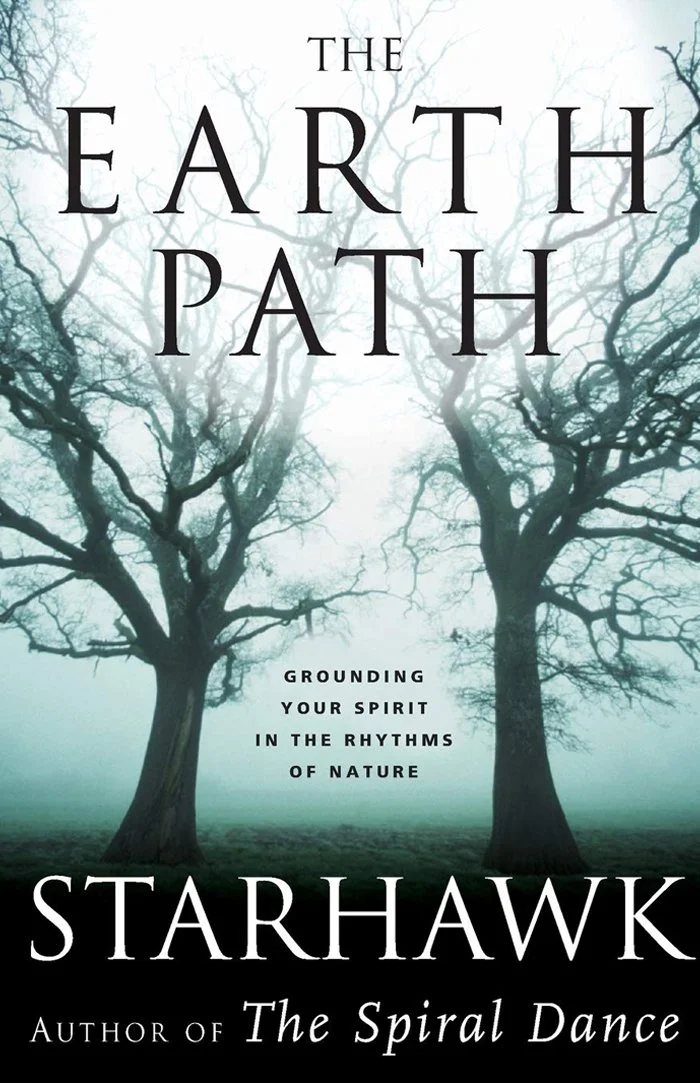
✎ Book
‘The Earth Path: Grounding Your Spirit in the Rhythms of Nature’
by Starhawk -
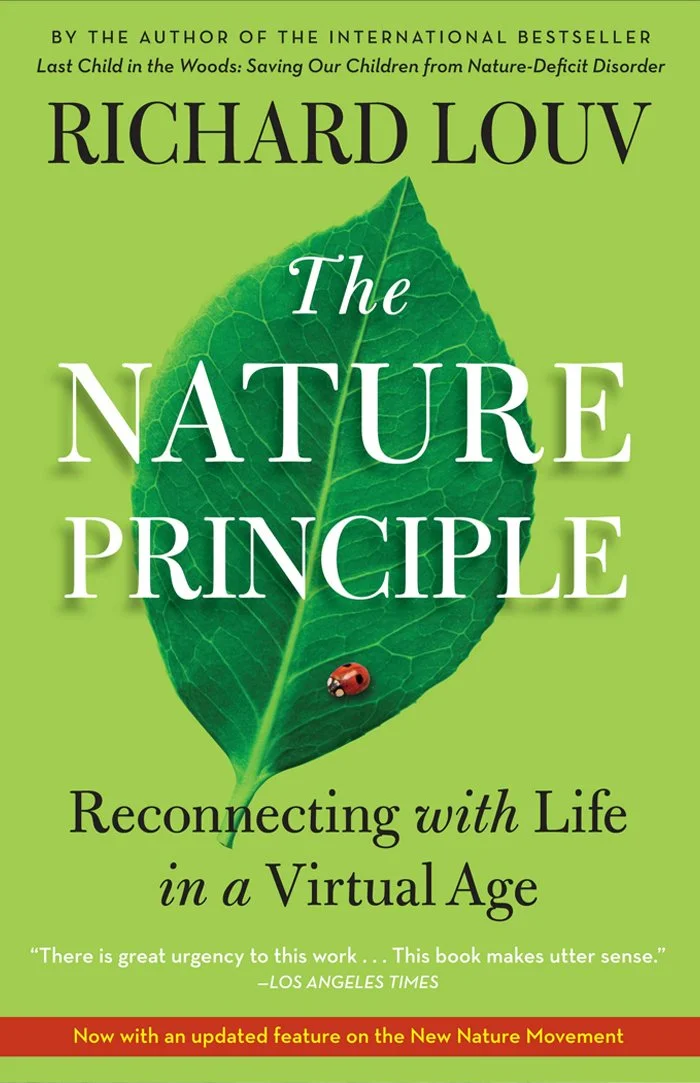
✎ Book
‘The Nature Principle (Reconnecting with Life in a Virtual Age)’
by Richard Louv -
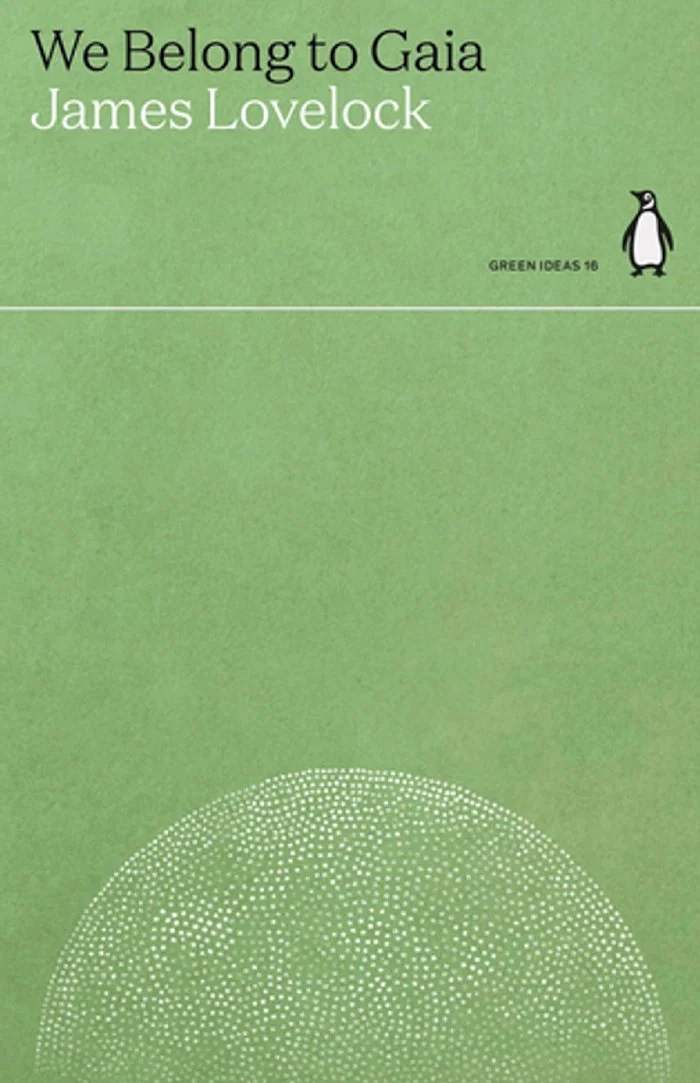
✎ Book
‘We Belong to Gaia’
by James Lovelock -
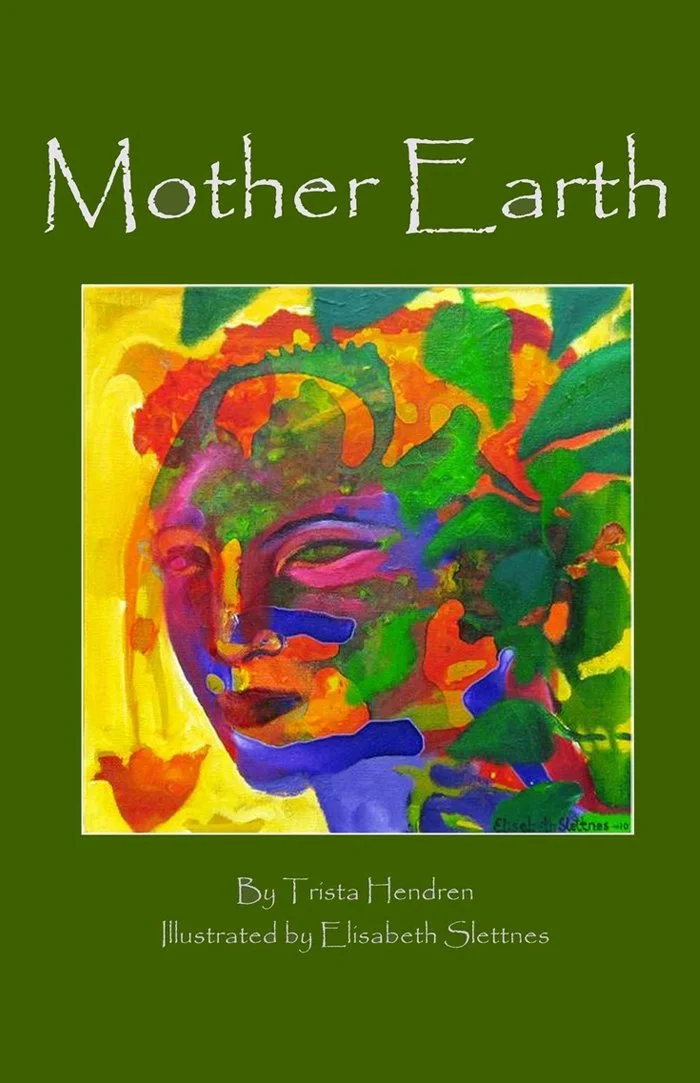
✴ Illustrated Book
‘Mother Earth’
by Trista Hendren & Elisabeth Slettnes -
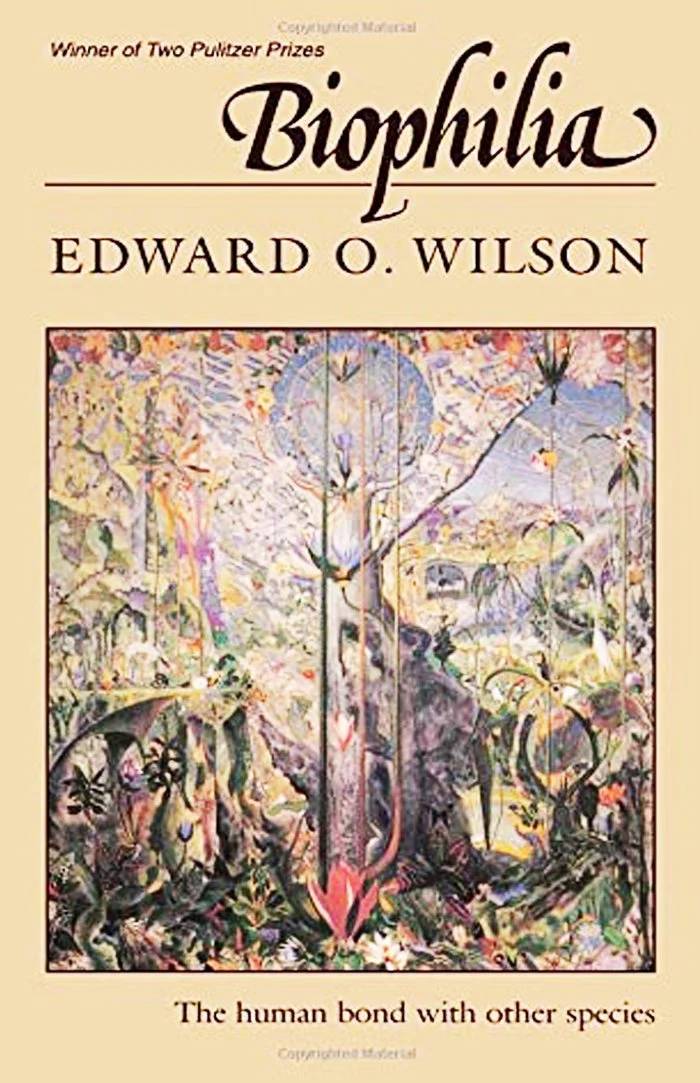
✎ Book
‘Biophilia’
by Edward O. Wilson -
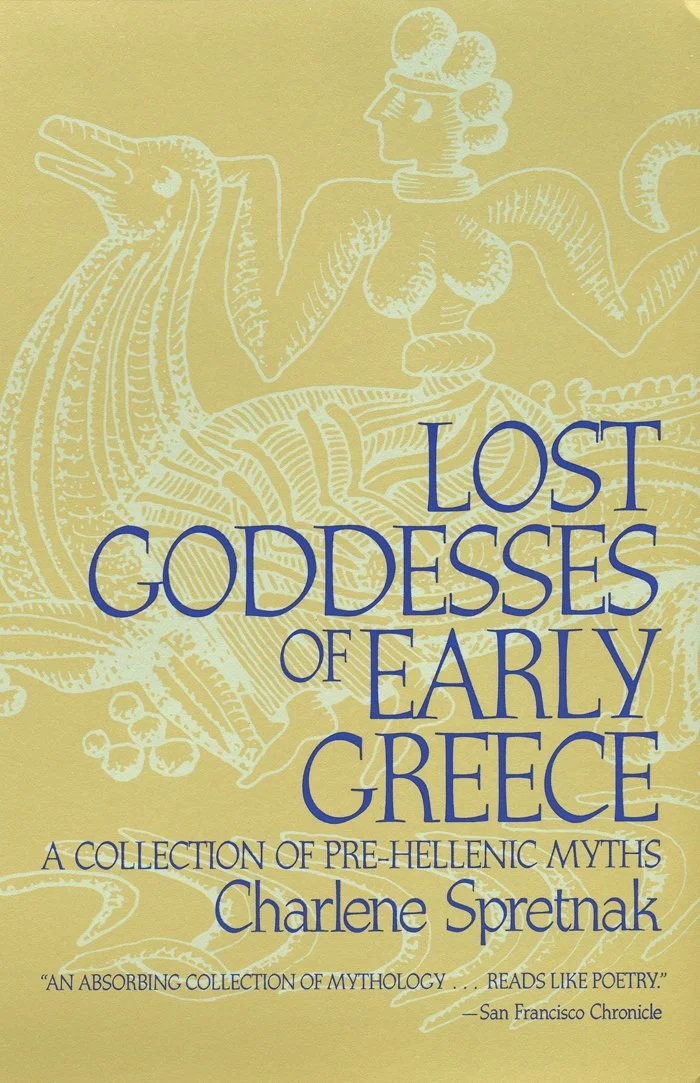
✎ Book
‘Lost Goddesses of Early Greece: A Collection of Pre-Hellenic Myths’
by Charlene Spretnak -

✎ Book
‘Primal Myths: Creation Myths Around the World’
by Barbara C. Sproul -
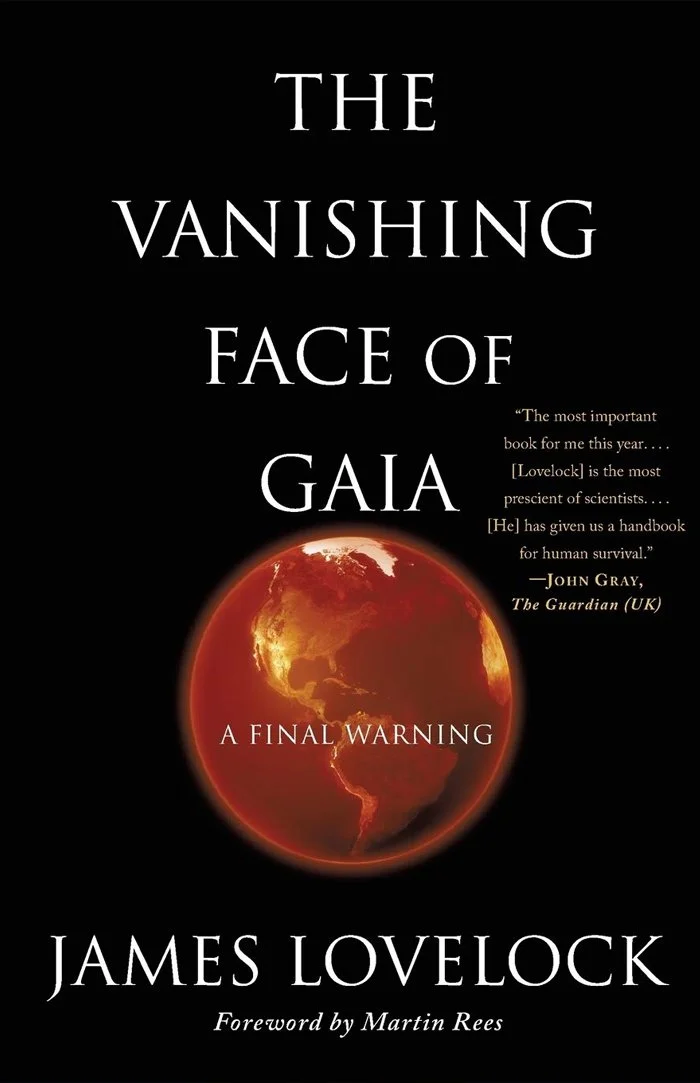
✎ Book
‘The Vanishing Face of Gaia: A Final Warning’
by James Lovelock -

✤ Article
‘Spiritual Ecology: The Living, Breathing World of Animism’
by Kyle Pearce -
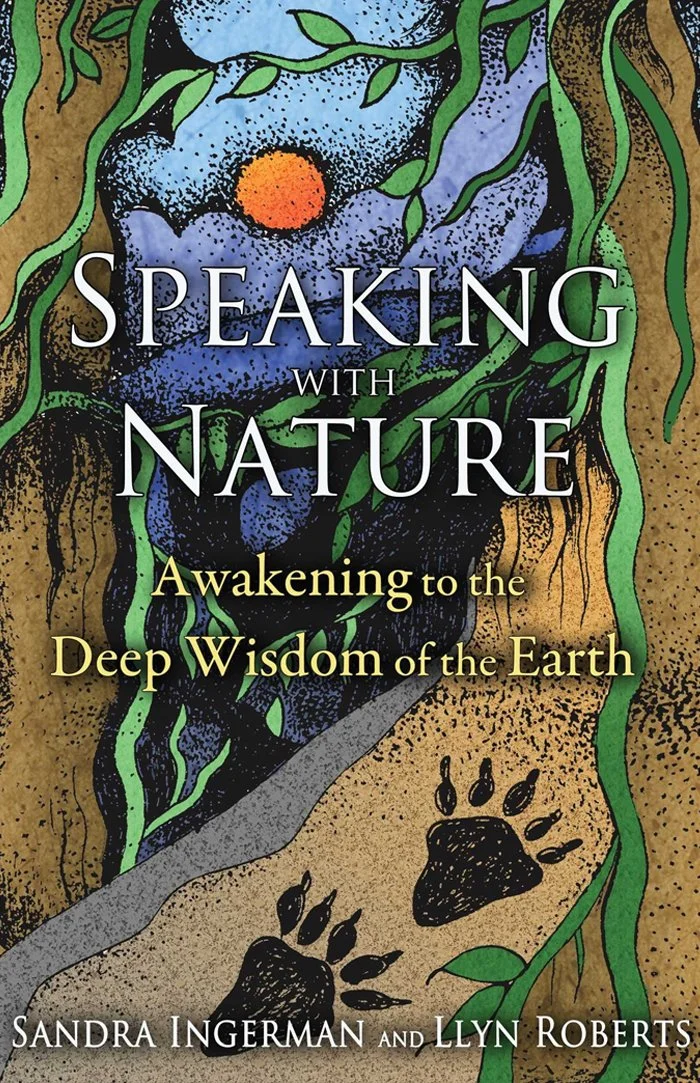
✎ Book
‘Speaking with Nature: Awakening to the Deep Wisdom of the Earth’
by Sandra Ingerman & Llyn Roberts -
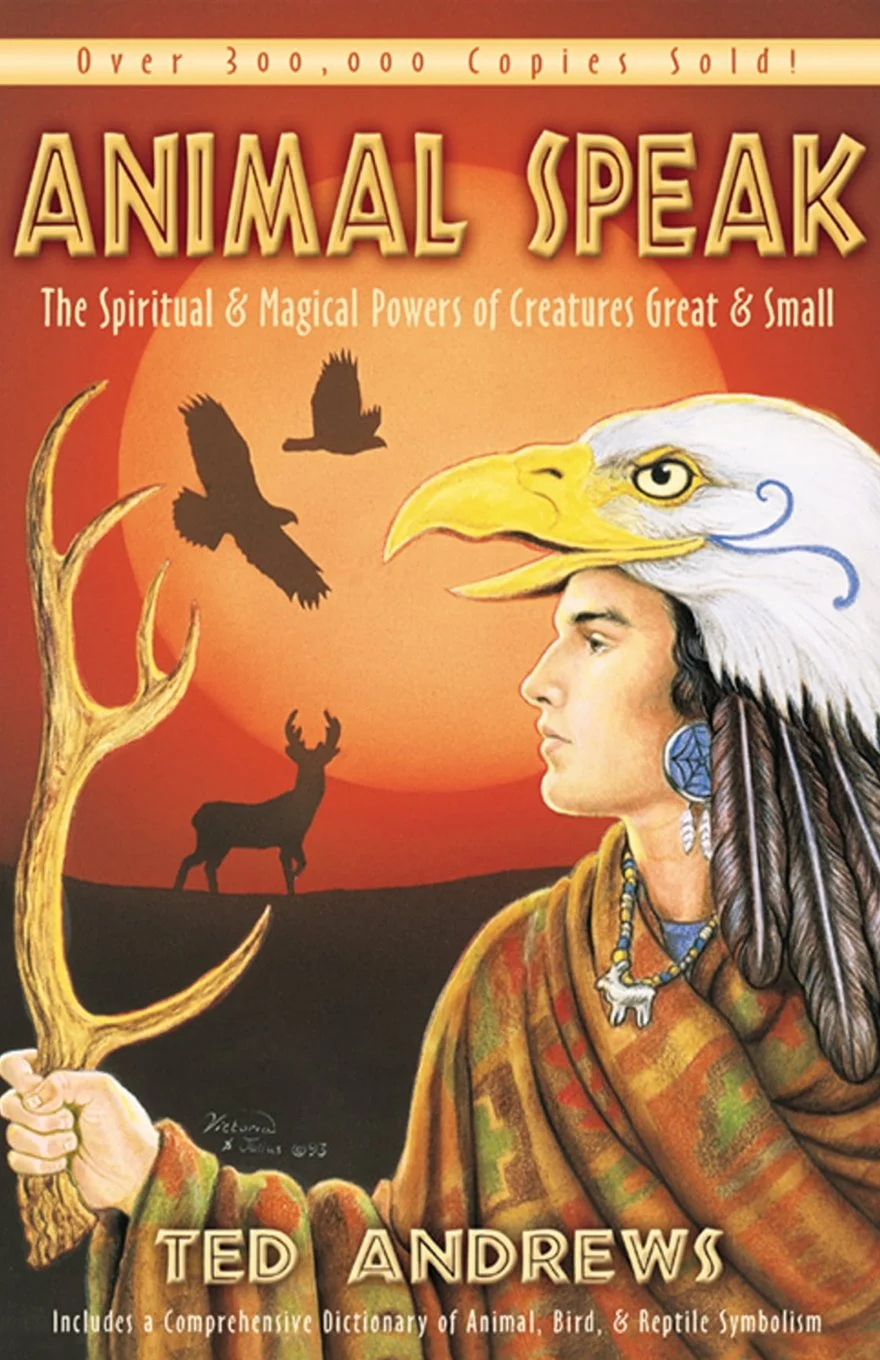
✎ Book
‘Animal Speak: The Spiritual & Magical Powers of Creatures Great and Small’
by Ted Andrews -
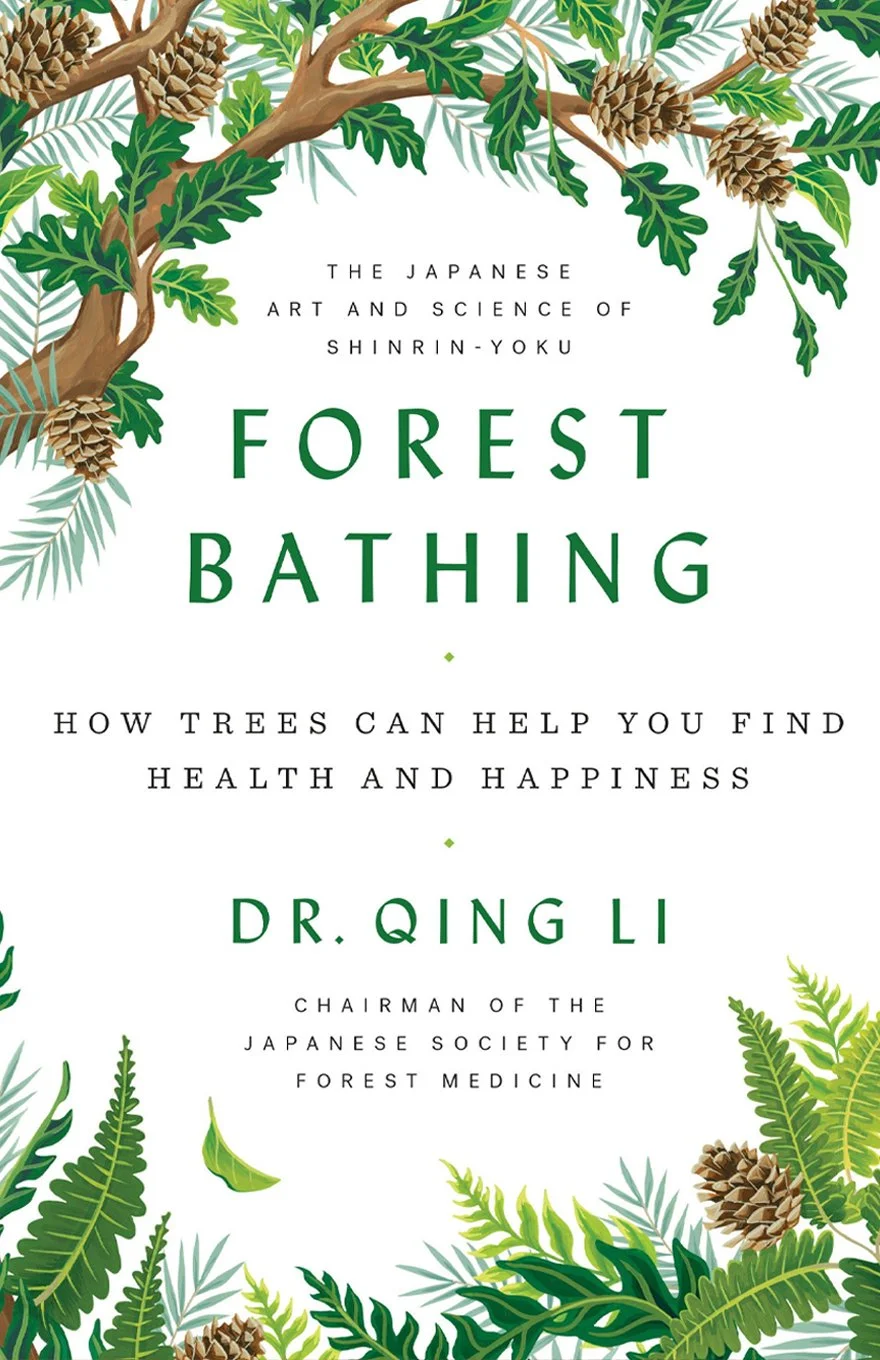
✎ Book
‘Forest Bathing: How Trees Can Help You Find Health and Happiness’
by Dr. Qing Li
Image Credits:
Thanh Nhàn • Menghui Huang • Ravynne Phelan • Mimby Jones Robinson • Kyle Gray • Magdalena Korzeniewska • Asia Orlando • Nondev • Aitch • Lisa Hunt • Paola Escobar • Killien Huynh
